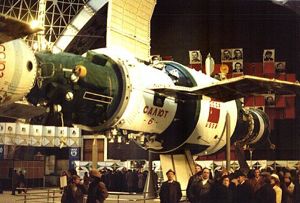
Home - Search - Browse - Alphabetic Index: 0- 1- 2- 3- 4- 5- 6- 7- 8- 9
A- B- C- D- E- F- G- H- I- J- K- L- M- N- O- P- Q- R- S- T- U- V- W- X- Y- Z
Salyut

Salyut 6
Salyut 6 as displayed in Moscow in 1981.
Credit: © Mark Wade
On 3 July 1969 the second Soviet N1 lunar launch vehicle blew up on the pad. 17 days later, Neil Armstrong stepped onto the moon, winning for the Americans the moon race. With the collapse of the work on the N1, the whole reason for Mishin's design bureau's existence simply vanished in the air. A new high-priority project was needed.
In terms of space stations, Mishin was thinking on a large scale. Korolev had begun development of a Multi-Module Space Base (MKBS) before 1966. However MKBS was to be launched by the N1; as long as this was not available, there would be no MKBS. Chief Designer Chelomei's military space station, the Almaz, did not require a new launch vehicle, although the UR-500 was in a period of intense 'baby sickness'. So while Mishin's TsKBEM was in a period of analysis and instability, Chelomei's Reutov and Fili factories were building space station for the Ministry of Defence.
On one of those August 1969 days, TsKBEM engineering managers Raushenbach, Legostayev, and Bashkin came to Mishin's deputy Chertok with a plan to take an Almaz spaceframe, install Soyuz systems, add a new docking tunnel with a hatch to reach the interior, and presto - a space station was finished. It would weigh only 18 metric tons, could be launched by a Proton UR-500K, and could be ready in one year. A new ECS would be required, but Oleg Suguchev and Ilya Lavrov confirmed this would not be a problem - they could develop a new system in one year, using existing pumps and components. Chertok checked with Isayev if the Soyuz engine unit could be adapted to handle a spacecraft of three times the mass and was told this was not a problem. Tentative discussions with potential allies within Chelomei's design bureau found support there as well.
The DOS 'long-duration orbiting station' was the result of this 'conspiracy' - an alliance of engineers at Mishin's TsKBEM Filial 1 and Chelomei's TsKBM (V N Bugayskiy, Khrunichev ZIKh factory director M I Rishiteh). They had got to know each other on the forced collaboration of the two bureaus on the L1 manned circumlunar project. They managed to go around their two chief designers and have the concept presented by D F Ustinov to the Central Committee of the USSR for Military Issues.
Almaz was converted to the DOS configuration by :
- Adding an Exit Section (PKhO) with a passive Soyuz docking system and airlock to the front of the station;
- Adding an Engine Section (AO) adapted from that of Soyuz to the rear of the station;
- Mounting Soyuz solar panels (SB) on the PKhO and AO.
But Mishin was opposed to the concept - he wanted to pursue the MKBS. Afanasyev and his deputy were equally opposed, and Tyulin wouldn't support the idea either. None of them wanted to take the risk. The only chance was to get to Ustinov through Communist party channels. The opportunity came in October 1969 on the flight of engineers and management to Baikonur for the Soyuz 6/7/8 flight. Feoktistov had prepared a briefing which he presented to Ustinov.
In the euphoria after the return of the Soyuz crews, the problem was how to get Ustinov to meet further with the DOS 'conspirators'. Mishin had prohibited any meetings by TsKBEM staff with the Communist Party Secretary unless Mishin was also present. Another obstacle was that Feoktistov was not a party member; how could his presence at a party meeting be explained to Mishin later?
In any event this was simply ignored. Feoktistov was present at a party meeting with Keldysh, Afanasyev, Tyulin, Serbin, and the Ministry of Defense's party cell: Strogonov, Kravtsev, and Popov. Keldysh was mainly worried how the project would affect the N1, but was reassured that the N1 had a dedicated work force, and the L3 lunar lander spacecraft engineers and workers that would work on DOS were currently idle and had no part of that work. It was finally decided to go ahead with the DOS no earlier than January, to allow time for Ministry Decrees, approval of a work plan by the VPK, preparation of a decree for signature by the Central Committee of the Communist Party and the Soviet Ministers. Work began on the project in December 1969 under the initial auspices of the Academy of Sciences.
After the meeting, convinced of Ustinov's support, the 'conspirators' were left with just a year to build the station. Engineers immediately started switch from the dead-end L3 lunar spacecraft effort to DOS. Bushuev was worried that this only sealed the fate of the N1. It was in any case important that the matter be formalized quickly. Being discovered working on it would be an embarrassment.
The biggest new development required was the docking collar and hatch unit. Semenov (L1 manager, and later head of RKK Energia) was the obvious project leader - the L1 had only two flights to go and he had demonstrated on that project the ability to maintain good communications and relations with OKB-52 and Chelomei. But how did they know whether he would support the DOS concept?
The 'conspiracy' came out in the open on 6 December 1969 Afanasyev met with the Chief Designers - Pilyugin, Ryazanskiy, V Kuznetsov, and Chelomei's Deputy, Eydis. Mishin was 'sick' and Chelomei had sent his deputy, as usual, to avoid having to meet Mishin. Afanasyev started with the demand that an Almaz flight take place within less than two years, before the end of the Eighth Five Year Plan. He asked Eydis to install an Igla passive docking system to permit docking with the station of the existing Soyuz 7K-OK as opposed to the planned 7K-S. If Chelomei's bureau could not meet this requirement, then the 'conspirator's' DOS project could be authorized in its place.
An extensive discussion of the future course of the Soviet manned space program followed. Eydis pleaded that the Almaz program not be infringed upon. If an early station was desired, completion of an Almaz could be started on 1 January. The station would not have any military systems or ECS ready, but could be modified for docking with a 7K-OK. He noted that work on Almaz had been underway since 1965, all based on the requirements of the Ministry of Defence. TsUKOS and the General Staff wanted to conduct research in reconnaissance systems - infrared, wide-spectrum, high resolution, and television transmission. Their objectives went far beyond launch of a simple space station.
Throughout these discussions Afanasyev did not praise or criticize any of the speakers. Obviously he had to formally discuss the matter with Ustinov before any decision could be made. The decisive meeting came on 26 December 1969. Ustinov called the DOS 'conspirators' to Kuibyshev Street. Mishin was sent away to Kslovodsk and Chelomei and Glushko were not invited. No one wanted to listen to any more of Glushko's diatribes about Kuznetsov's engines.
Ustinov supported presentation of the DOS concept to the Central Committee. Chelomei categorically opposed DOS and was trying to kill it through military channels. But the allure of an '18 month' station - one which would not only beat the American Skylab, but be in space in time for the 24th Party Congress - seemed too alluring. Mishin also rejected DOS, but deputies at both design bureaus supported the concept and were eager to proceed.
DOS was therefore created only when the moon project failed. Chelomei was forced to work on DOS, and it severely impacted Almaz schedules. The Salyut name was later applied to both the DOS and Almaz stations, creating the impression in the outside world that they were built by one designer.
The official ministry decrees starting the DOS and reorganizing the Almaz projects were issued in February 1970. The co-operative DOS crash program was to build a civilian space station to beat Skylab into orbit. Mishin's OIS military station was cancelled and Chelomei's Almaz would continue, but as second priority to the civilian station. The Soyuz 7K-S station ferry, the 7K-ST, would be revised to be a more conservative modification of the Soyuz 7K-OK. The OIS cosmonaut group was to be incorporated into the Almaz group.
The relevant Ministry of General Machine Building (MOM) Decree 105-41 'On creation of the DOS using Almaz as a basis' was issued on 9 February, followed by Decree 57ss 'On creation of the DOS using Almaz as a basis' on 16 February. The first station was to be completed within a year. On 15 February Ustinov had conferred with the Cabinet. They agreed that work would continue on both the lunar expedition and DOS. A formal declaration from Mishin and Chelomei to work together was required.
On 5 May 1970 Smirnov and Afanasyev settled the future course of manned spaceflight at a DOS project review. Almaz and DOS would continue in the short term, but MKBS would follow in earth orbit. Mishin's attempt to replace Almaz with his DOS-A design was defeated.
Work on the DOS station had begun in February 1970 using Almaz s/n 121 and 122. The first station was shipped in February 1971 to Baikonur, where work continued to complete it day and night without break. The station was to be called Zarya, or 'Dawn', but the name was changed just before launch to prevent confusion with the identical ground control call sign. Instead DOS-1 became known as Salyut 1. The station was launched on 19 April 1971 as Salyut 1. The triumph turned to tragedy when the Soyuz-11 crew died due to de-pressurization of their re-entry capsule during return to the earth after completion of a 21 day mission aboard the station.
Collaboration of the two chief designers did lead to some agreements, although these were contrary to government decrees. Chelomei was anxious to develop Almaz while Mishin wished to move on with the N1 booster to MKBS and the moon. On 3 February 1972 Mishin and Chelomei sent a joint letter to Afanasyev. They proposed that Almaz would take over the DOS role as a civilian station after the four DOS-1's had been launched. Faced for once with a show of unanimity, Afanasyev rejected the plan. He replied that under no circumstances was Almaz to be used for scientific research. On the other hand, DOS would require substantial rework to be capable of military research. Therefore, the designers were to keep to original plan:
- Complete build of 4 DOS-1 as per Decree of Central Committee and Soviet Ministers #105-41 of 9 February 1970
- Continue scientific research on DOS only
- Almaz to be resupplied by the Soyuz 7K-T developed for DOS, to be followed by the Soyuz 7K-S, developed to the TTZ specification of the Ministry of Defence
- For flight trials of the MKBS, to return from the MOK large station, use the TKS of Almaz, developed according tot he decree 437-160 of 16 June 1970
- Apollo to dock with Soyuz-M 7K-M as per decree of 14 July 1972.
Launches of the first series DOS stations continued in a desperate effort to beat Skylab into orbit with a fully successful Soviet space station mission. DOS-2, s/n 122, was destroyed in a launch vehicle explosion en route to orbit in July 1972. DOS-3, s/n 123, reached orbit as Cosmos 557 in 1973 but control was lost before a crew could be sent to the station. Chelomei launched his first Almaz the same year. It reached orbit and was designated Salyut 2 but depressurized and was abandoned before a crew could be sent.
DOS-4 finally flew successfully as Salyut 4 in 1974. The cancellation of the N1 booster in 1974 left Salyut as the only Soviet civilian manned space program.
To support operation of these stations the basic Soyuz design was modified by addition of a docking tunnel. The resulting Soyuz 7KT-OK was used with the Salyut 1 DOS space station. Following the disastrous Soyuz 11 mission, it was again reworked to the simplified Soyuz 7K-T design, which finally provided a reliable ferry craft to Salyut-4.
| DOS 2-1 Null |
| DOS 2-2 Null |
| DOS 2-3 Null |
| DOS 2-4 Null |
| Salyut 7/TKS-2 Planned TKS manned mission to Salyut 7 station. Cancelled December 1981; TKS-2 flew unmanned to Salyut 7 as Cosmos 1443. |
| Salyut 7/TKS-3 Planned second manned flight of TKS ferry to the Salyut 7 space station. The crews were assigned in September/October 1979. But in December 1981 Ustinov finally killed Chelomei's plans for manned TKS flights. The TKS training group was dissolved and TKS-3 flew unmanned to Salyut 7 as Cosmos 1686. |
| Soyuz 10 Intended first space station mission. Hard dock with station could not be achieved. Then stuck and could separate from the station only after repeated attempts. Toxic fumes in air supply during landing overcame one astronaut. |
| Soyuz 11 First space station mission. Record flight duration. Main telescope inoperative. Fire in space station put out. Fail-safe valve opening during re-entry, resulted in decompression and death of entire crew. |
| Soyuz 12 Experimental flight for the purpose of further development of manned space craft Soyuz 7K-T modifications. After the Soyuz 11 disaster, the Soyuz underwent redesign for increased reliability. |
| Soyuz 12 / DOS 1 If the Soyuz 11 crew had not perished during return to the earth, the Leonov crew would have been sent for a second visit to the Salyut 1 space station. A 30-day mission duration was planned. |
| Soyuz 12 / DOS 2 Planned first mission to the Salyut DOS 2 space station. Cancelled after DOS 2 was destroyed during launch. |
| Soyuz 12 / DOS 3 Planned first mission to the Salyut DOS 3 space station (Cosmos 557). Cancelled after Cosmos 557 failed in orbit. |
| Soyuz 13 First Byelorussian astronaut. First space mission devoted to a single scientific instrument. A unique flight of the 7K-T/AF modification of the Soyuz spacecraft. The orbital module was dominated by the large Orion 2 astrophysical camera. |
| Soyuz 13 / DOS 2 Planned second mission to the Salyut DOS 2 space station. Cancelled after DOS 2 was destroyed during launch. |
| Soyuz 13 / DOS 3 Planned second mission to the Salyut DOS 3 space station (Cosmos 557). Cancelled after Cosmos 557 failed in orbit. |
| Soyuz 17 First successful Russian civilian space station mission. Docked with Salyut 4. |
| Soyuz 18 Docked with Salyut 4. |
| Soyuz 18-1 First manned spaceflight abort. During launch third stage separation failed to occur. Crew aborted to 20 G landing in mountains near Chinese border, sliding down a slope towards a cliff until their parachute snagged on a tree. |
| Soyuz 25 Unsuccessful mission. Failed to dock with Salyut 6 due to damage to spacecraft's docking mechanism. |
| Soyuz 26 Record flight duration. First mission to receive visiting crews launched aboard another spacecraft, and to be resupplied by a logistics spacecraft. First Soviet EVA since Voskhod 2. First Main Expedition aboard Salyut 6. |
| Soyuz 26A Planned mission to Salyut 6 that would make first docking with rear docking port and be the first crew to swap spacecraft and return in the spacecraft that ferried the Soyuz 25 crew. But Soyuz 25 failed to dock with Salyut 6. |
| Soyuz 27 First docking to a space station of two manned spacecraft at one time. First station 'lifeboat' swap. First crew to visit another already aboard a space station. |
| Soyuz 28 First Czech astronaut. Mission to swap Soyuz lifeboats docked to station. |
| Soyuz 29 Record flight duration. Docked with Salyut 6. First transfer of a Soyuz from the aft port to the front port of a space station. |
| Soyuz 30 First Polish astronaut. Docked with Salyut 6. Mission to swap Soyuz lifeboats docked to station. |
| Soyuz 31 First German astronaut. Docked with Salyut 6. Mission to swap Soyuz lifeboats docked to station. |
| Soyuz 32 Record flight duration. Docked with Salyut 6. Repaired the propulsion system, which had sprung leaks. |
| Soyuz 33 First Bulgarian astronaut. Mission to swap Soyuz lifeboats docked to station. |
| Soyuz 35 Record flight duration. Docked with Salyut 6. |
| Soyuz 36 First Hungarian astronaut. Mission to swap Soyuz lifeboats docked to station. |
| Soyuz 37 First Vietnamese astronaut. Mission to swap Soyuz lifeboats docked to station. |
| Soyuz 38 First Cuban astronaut. Docked with Salyut 6. Mission to swap Soyuz lifeboats docked to station. |
| Soyuz 39 First Mongolian astronaut. Docked with Salyut 6. Mission to swap Soyuz lifeboats docked to station. |
| Soyuz 40 First Rumanian astronaut. Docked with Salyut 6. Mission to swap Soyuz lifeboats docked to station. |
| Soyuz T-10 Record flight duration. Crew entered the failed darkened station carrying flashlights. Reactivated station, attempted propellant system repairs. After their departure the unoccupied space station abruptly ceased communicating. |
| Soyuz T-10-1 First manned pad abort. Launch vehicle blew up on pad, crew rescued by launch escape tower, which pulled their capsule away at 20 G's. |
| Soyuz T-11 First Indian astronaut. Mission to swap Soyuz lifeboats docked to station. |
| Soyuz T-12 First woman to walk in space, accomplished for propaganda purposes ahead of plans for NASA female astronaut EVA. Mission to swap Soyuz lifeboats docked to station. |
| Soyuz T-13 EO-4-a First manned operations in a second space station module. The three-man EO-4 TKS-3 crew conducted military experiments with the Cosmos-1686 module. Mission was cut short due to an incapacitating psychological condition developed by Vasyutin. |
| Soyuz T-13 EO-4-b First docking with and repair of dead-in-space station. Crew carried out emergency repairs. |
| Soyuz T-13A Planned mission to operate military experiments aboard Salyut 7. Cancelled due to technical and personnel problems aboard station. |
| Soyuz T-14 EO-4-c First manned operations in a second space station module. The three-man EO-4 TKS-3 crew conducted military experiments with the Cosmos-1686 module. Mission was cut short due to an incapacitating psychological condition developed by Vasyutin. |
| Soyuz T-14 Salyut 7 EP-5 Mission to swap Soyuz lifeboats docked to station and conduct an inspection of the repairs conducted the Soyuz T-13 crew. |
| Soyuz T-15A Final 'civilian' expedition to Salyut 7 station with Buran pilot aboard for spaceflight familiarization was cancelled when control of the station was lost. |
| Soyuz T-15B Cancelled second crew to operate TKS-3 military experiments aboard Salyut 7. These had been left uncompleted with the early return of the EO-4-2 crew due to Vasyutin's illness. |
| Soyuz T-15C To have docked with Mir. Cancelled all-female flight to be launched on International Woman's Day. Breakdown of Salyut 7, exhaustion of stock of Soyuz T spacecraft, and official resistance led to cancellation of the mission. |
| Soyuz T-2 Test flight of new Soyuz T spacecraft; docked with Salyut 6. |
| Soyuz T-3 Docked with Salyut 6. Tested the improved Soyuz T; carried out repair and preventive maintenance work and some scientific and technical investigation and experiments. |
| Soyuz T-3A Planned but cancelled manned flight. Crew dissolved when Lazarev failed physical in early 1981. |
| Soyuz T-4 Docked with Salyut 6. Carried out repair and preventive maintenance work and some scientific and technical investigation and experiments. |
| Soyuz T-5 Record flight duration. Ejected a 28-kg amateur radio satellite from a Salyut 7 trash airlock; called this the first launch of a communications satellite from a manned space vehicle. |
| Soyuz T-6 First French astronaut. Mission to swap Soyuz lifeboats docked to station. |
| Soyuz T-7 Second woman in space, launched for propaganda purposes ahead of first flight of NASA female astronauts aboard the shuttle. Mission to swap Soyuz lifeboats docked to station. |
| Soyuz T-8 Unsuccessful mission. Igla approach system antenna was damaged during ascent; failed to rendezvous with Salyut 7. Further attempts to man Salyut 7 could not take place for two months because of launch and abort lighting constraints. |
| Soyuz T-9 Docked with Salyut 7. Unloaded cargo from Cosmos 1443; loaded 350 kg of payload into it for return to earth. |
People: Shatalov, Lazarev, Dobrovolsky, Yazdovsky, Kolodin, Vorobyov, Gubarev, Grechko, Ponomaryov, Rukavishnikov, Makarov, Patsayev, Leonov, Yeliseyev, Kubasov, Sevastyanov, Volkov, Kovalyonok, Lebedev, Klimuk. Country: Russia. Spacecraft: Salyut 1, Soyuz 7KT-OK, Soyuz 7K-T, Salyut 4, Soyuz 7K-T/A9, Soyuz 7K-S. Flights: Soyuz 10, Soyuz 11, Soyuz 12 / DOS 1, DOS 2-1, DOS 2-2, DOS 2-3, DOS 2-4, Soyuz 12 / DOS 2, Soyuz 13 / DOS 2, Soyuz 12 / DOS 3, Soyuz 13 / DOS 3, Soyuz 12, Soyuz 13, Soyuz 17, Soyuz 18-1, Soyuz 18, Soyuz 26A. Launch Vehicles: Soyuz 11A511, Proton-K, Soyuz-U. Launch Sites: Baikonur. Agency: RVSN, MOM.
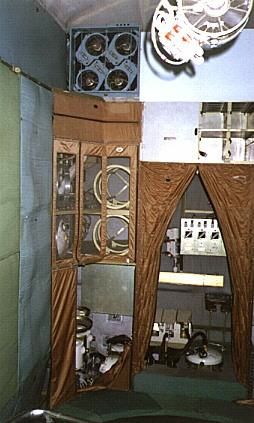 | Salyut 4 rear int. Salyut 4 view of rear interior of station Credit: © Mark Wade |
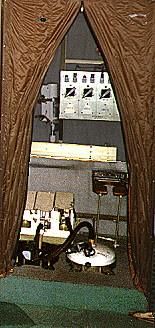 | Salyut 4 toilet View of Salyut 4 toilet facility - you always wanted to know how they do it in space... Credit: © Mark Wade |
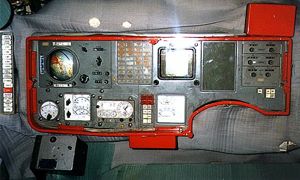 | Salyut 4 Main Panel Salyut 4 Main Control Panel - adopted unchanged from Soyuz 7K-OK Credit: © Mark Wade |
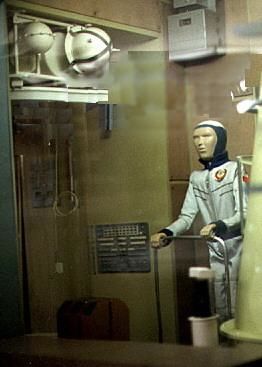 | Salyut 6 model Salyut 6 model showing cosmonaut on treadmill and bulk of solar camera on the right Credit: © Mark Wade |
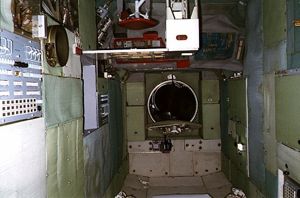 | Interior of Salyut 4 Interior of Salyut 4 looking forward. Credit: © Mark Wade |
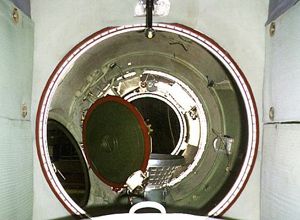 | Salyut 4 airlock Salyut 4 airlock compartment Credit: © Mark Wade |
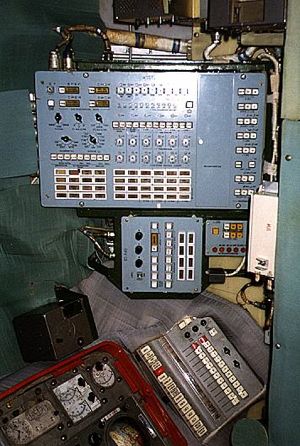 | Salyut 4 panel Salyut 4 Control Panel - above and to the right of the main station control panel Credit: © Mark Wade |
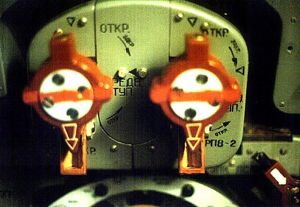 | Soyuz T panel Soyuz T control panel 5 Credit: © Mark Wade |
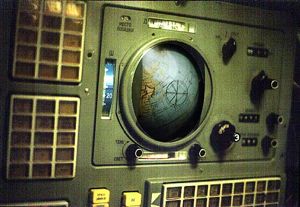 | Soyuz T panel Soyuz T control panel 4 Credit: © Mark Wade |
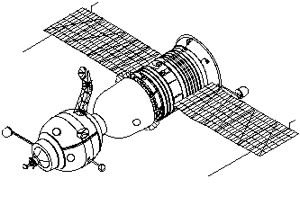 | Soyuz 7K-OKS Credit: © Mark Wade |
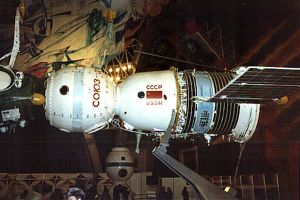 | Soyuz 7K-T Credit: © Mark Wade |
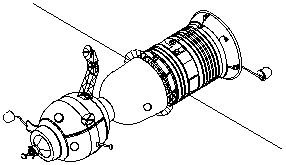 | Soyuz 7K-T Credit: © Mark Wade |
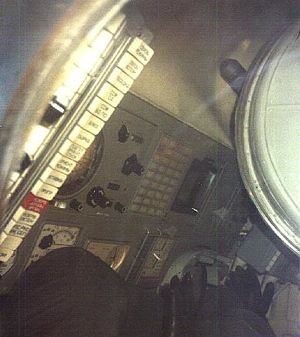 | Soyuz Interior View of Soyuz interior. Credit: © Mark Wade |
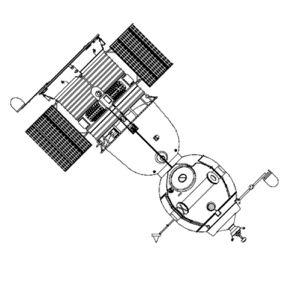 | Soyuz 7K-OKS Credit: © Mark Wade |
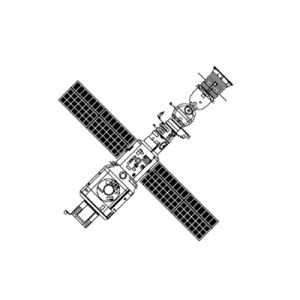 | Salyut 4 Credit: © Mark Wade |
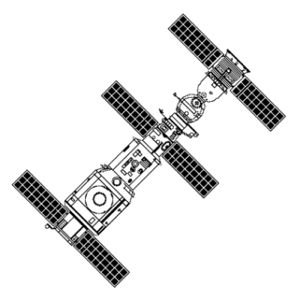 | Salyut 1 The Salyut 1 was the world's first space station. It was developed in a crash project that took military Almaz space station hulls and equipped them with Soyuz systems. Credit: © Mark Wade |
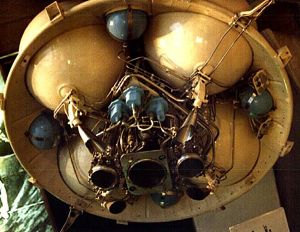 | Salyut 6 Engines Close-up of the engines of Salyut 6 as displayed in Moscow in 1981. Credit: © Mark Wade |
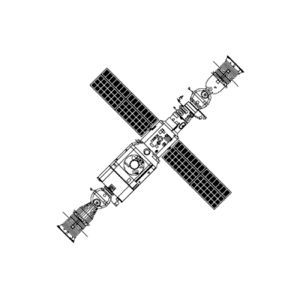 | Salyut 6 Salyut 6 as displayed in Moscow in 1981. Credit: © Mark Wade |
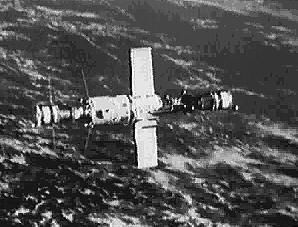 | Salyut 6 In Space Credit: RKK Energia |
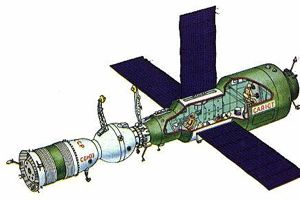 | Salyut 6 Cutaway The Salyut 6 space station was the first evolved design with two docking ports. Credit: RKK Energia |
 | Progress View of the original Progress spacecraft, as displayed in Moscow in 1981. Credit: © Mark Wade |
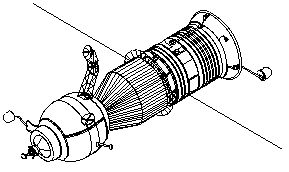 | Progress Drawing of the initial version of the Progress refuelling spacecraft. Credit: © Mark Wade |
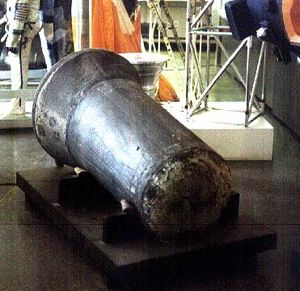 | Progress capsule View of the Progress 'Raduga' mini-capsule used for recovery of materials from the Mir station. Credit: © Mark Wade |
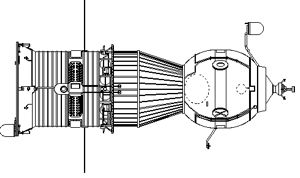 | Progress Drawing of the initial version of the Progress refuelling spacecraft. Credit: © Mark Wade |
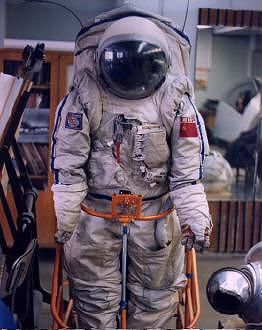 | Spacesuit Orlan Orlan space suit as used on Salyut 7 and Mir space stations. Credit: Zvezda |
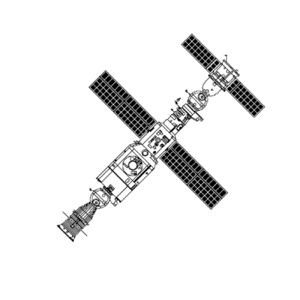 | Salyut 7 Credit: © Mark Wade |
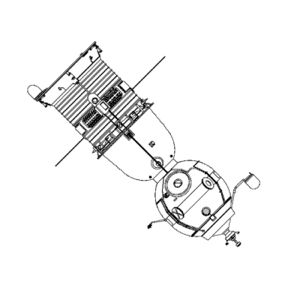 | Soyuz 7K-T Credit: © Mark Wade |
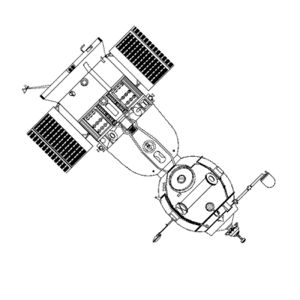 | Soyuz T Credit: © Mark Wade |
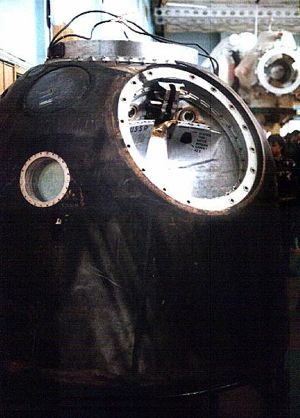 | Soyuz Descent Module Credit: © Mark Wade |
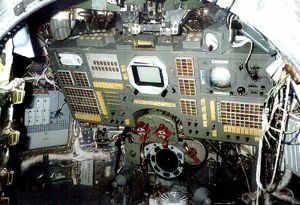 | Soyuz T panel Soyuz T control panel Credit: © Mark Wade |
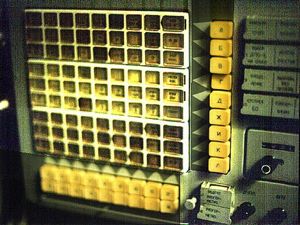 | Soyuz T panel Soyuz T control panel 1 Credit: © Mark Wade |
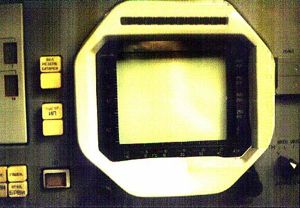 | Soyuz T panel Soyuz T control panel 2 Credit: © Mark Wade |
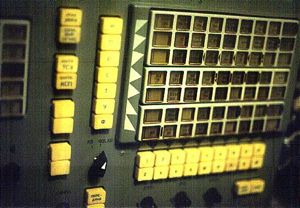 | Soyuz T panel Soyuz T control panel 3 Credit: © Mark Wade |
 | Soyuz escape rocket Soyuz launch escape system Credit: © Mark Wade |
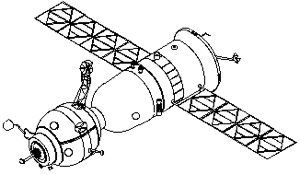 | Soyuz T Credit: © Mark Wade |
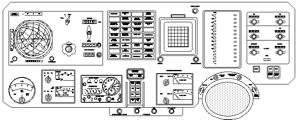 | Panel Soyuz 7K-OK Control panel of the initial earth orbit version of Soyuz. Credit: © Mark Wade |
1969 August 1 - . LV Family: Proton. Launch Vehicle: Proton-K/D.
- The DOS Conspiracy begins - .
Nation: Russia.
Related Persons: Chelomei,
Mishin.
Program: Lunar L3,
Almaz,
Salyut.
Spacecraft: Almaz OPS,
LK,
MKBS,
Soyuz 7K-LOK.
With the collapse of the work on the N1, the whole reason for Mishin's design bureau's existence simply vanished in the air. A new high-priority project was needed. Korolev had begun development of a Multi-Module Space Base (MKBS) before 1966. However MKBS was to be launched by the N1; as long as this was not available, there would be no MKBS. Almaz on the other hand did not require a new launch vehicle, although the UR-500 was in a period of intense 'baby sickness'. So while TsKBEM was in a period of analysis and instability, Chelomei's Reutov and Fili facilities were building space stations for the Ministry of Defence.
On one of these August 1969 days, three of Chelomei's TsKBM engineers came to the office of Mishin's deputy, Chertok, with a plan to get a space station orbited before the American Skylab. They wanted a collaboration between the two competing design bureaux. Their plan was to take an Almaz spaceframe, install Soyuz systems, add a new docking tunnel with a hatch to reach the interior, and presto - a space station was finished. Tentative discussions with potential allies within Chelomei's design bureau found support there as well. The DOS 'long-duration orbiting station' was the result of this 'conspiracy'.
1969 October 5 - .
- DOS Conspiracy briefed to Ustinov - .
Nation: Russia.
Related Persons: Afanasyev, Sergei,
Feoktistov,
Mishin,
Tyulin,
Ustinov.
Program: Lunar L3,
Almaz,
Salyut.
Spacecraft: LK,
Soyuz 7K-LOK.
Mishin was opposed to the DOS space station concept - he wanted to pursue the N1-launched MKBS. Afanasyev and Deputy Minister Tyulin wouldn't support the idea either. None of them wanted to take the risk. The only chance was to get to VPK Chairman Ustinov through Communist party channels. The opportunity came on the flight of engineers and management to Baikonur for the Soyuz 6/7/8 flight. Feoktistov had prepared a briefing on DOS, which he presented to Ustinov.
1969 October 19 - .
- DOS Conspiracy briefed to wide circle of space planners - .
Nation: Russia.
Related Persons: Afanasyev, Sergei,
Bushuyev,
Chelomei,
Feoktistov,
Keldysh,
Mishin,
Semenov,
Serbin,
Tyulin,
Ustinov.
Program: Lunar L3,
Almaz,
Salyut.
Spacecraft: Almaz OPS,
LK,
Salyut 1,
Soyuz 7K-LOK.
In the euphoria after the return of the Soyuz 6/7/8 crews, the problem was how to get Ustinov to meet further with the DOS 'conspirators'. Mishin had prohibited any meetings by TsKBEM staff with the Communist Party Secretary unless Mishin was also present. Another obstacle was that Feoktistov was not a party member; how could his presence at a party meeting be explained to Mishin later?
In any event these consideations were simply ignored. Feoktistov was present at a party meeting with Keldysh, Afanasyev, Tyulin, Serbin, and the Ministry of Defence's party cell: Strogonov, Kravtsev, and Popov. Keldysh was mainly worried how the project would affect the N1, but was reassured that the N1 had a dedicated work force, and the L3 lunar lander spacecraft engineers and workers that would work on DOS were currently idle and had no part of that work. It was finally decided to go ahead with the DOS no earlier than January, to allow time for Ministry Decrees, approval of a work plan by the VPK, preparation of a decree for signature by the Central Committee of the Communist Party and the Soviet Ministers. Work began on the project in December 1969 under the initial auspices of the Academy of Sciences. Additional Details: here....
1969 December 6 - .
- The DOS Conspiracy in the open - .
Nation: Russia.
Related Persons: Afanasyev, Sergei,
Chelomei,
Kuznetsov, Viktor,
Mishin,
Pilyugin,
Ryazanskiy,
Ustinov.
Program: Almaz,
Salyut.
Spacecraft: Almaz OPS,
Salyut 1,
Soyuz 7K-S,
Soyuz 7KT-OK.
Afanasyev met with the Chief Designers - Pilyugin, Ryazanskiy, V Kuznetsov, and Chelomei's Deputy, Eydis. Mishin was 'sick' and Chelomei had sent his deputy, as usual, to avoid having to meet Mishin. Afanasyev started with the demand that an Almaz flight take place within less than two years, before the end of the Eighth Five Year Plan. He asked Eydis to install an Igla passive docking system to permit docking with the station of the existing Soyuz 7K-OK as opposed to the planned 7K-S. If Chelomei's bureau could not meet this requirement, then the 'conspirator's' DOS project could be authorised in its place. Additional Details: here....
1969 December 26 - . Launch Vehicle: N1.
- DOS formally authorised - .
Nation: Russia.
Related Persons: Chelomei,
Glushko,
Kuznetsov,
Mishin,
Ustinov.
Program: Lunar L3,
Almaz,
Salyut.
Spacecraft: Almaz OPS,
Salyut 1.
Ustinov called the DOS 'conspirators' to Kuibyshev Street. Mishin was sent away to Kslovodsk and Chelomei and Glushko were not invited. No one wanted to listen to any more of Glushko's diatribes about Kuznetsov's engines.
Ustinov supported presentation of the DOS concept to the Central Committee. Chelomei categorically opposed DOS and was trying to kill it through military channels. But the allure of an '18 month' station - one which would not only beat the American Skylab, but be in space in time for the 24th Party Congress - seemed too alluring. Mishin also rejected DOS, but deputies at both design bureaux supported the concept and were eager to proceed.
DOS was therefore created only when the moon project failed. Chelomei was forced to work on DOS, and it severely impacted Almaz schedules. The Salyut name was later applied to both the DOS and Almaz stations, creating the impression in the outside world that they were built by one designer.
1970 January 19 - .
- Soviet leadership interest in manned spaceflight has collapsed. - .
Nation: Russia.
Related Persons: Belyayev,
Brezhnev,
Bykovsky,
Chelomei,
Mishin,
Popovich.
Program: Salyut,
Almaz,
Skylab.
Spacecraft: Almaz OPS,
Salyut 1,
Soyuz 7K-S.
Kamanin notes that interest of the leadership in manned spaceflight has collapsed with the end of the moon race. Brezhnev has declared that his primary interest is in earth orbital space stations. Both Mishin and Chelomei have stations in development, but the work is progressing slowly. There will be no launch of either of their projects until 1972 - which means the Soviets will be beaten by the US Skylab. Kamanin believes the Americans can never be beaten in space unless all space projects are guided firmly by a single Ministry of Defence and Civilian Space office. Meanwhile the Hong Kong flu epidemic is hitting many at the cosmodrome - Moroz, Popovich, and Bykovsky are all seriously ill.
1970 February 7 - .
- Soyuz 10 and 11 crew selections; Soyuz 9 experiment review - .
Nation: Russia.
Program: Salyut,
Soyuz.
Flight: Soyuz 10,
Soyuz 11,
Soyuz 9.
Spacecraft Bus: Almaz.
Spacecraft: Salyut 1.
Kamanin meets with nine generals involved in supervising aspects of the space programme. Only one is from the VVS aviation, the rest have artillery or rocket backgrounds. Naturally they have no bad words for the RSVN or TsUKOS. At the centre, crew selection for the Soyuz 10 and Soyuz 11 missions to the DOS space station are underway. A review is conducted of the biomedical and zero-G studies planned for Soyuz 9. This is followed by a meeting with General Komarov and the cosmonauts on plans for the new cosmonaut training building and a nine-story apartment building.
1970 February 16 - . LV Family: N1.
- Next five year plan emphasized the use of the N1 - .
Related Persons: Mishin,
Chelomei,
.
Spacecraft: Soyuz,
MKBS,
Almaz,
Salyut,
LK.
The next five year plan emphasized the use of the N1 for MKBS and robot soil return missions to Mars by the mid-1970's. But an N1M and improved lunar spacecraft would be developed for establishment of a moon base late in the decade. This was all laid out in a review of the proposed five-year plan on 16 February 1970 (Mishin Diaries 2-302):
25. Budget Review - 5 Year Plan (presumed in thousands of rubles)
Experimental design work - 8734
R&D - 680
Projected over 5 yrs
Experimental Base - 3314
N1-L3 - 2665 (Capital investments)
DOS - 170
Almaz - 645
Topaz - 750 (unknown code name).
Apparatus for military use - 825 350
National economy. others - 928 150
Launch Vehicles - 255 116
Launch complexes - 476 91
Skh.A. - 830 293
EYaRD - 380
Launch work - 780 760
N1-L3 71 72 73 74 75 +ú
(11A52) 3 4 4 4 2 17
11A52 for Mars-75 - - - - 2 2
Grand total 19
26. On the draft resolution for the MKBS.
1. Use the same cooperation established in the design and manufacture of DOS.
2. Expand the cooperation of developers in various departments (especially on power, life support systems, equipment for national economic and scientific purposes).
2. Create the necessary experimental and industrial base (with the planned cooperation of developers).
3. Select TsKBEM factory for serial instrument production with MOM.
4. Determine the organization within MOM (former Nikitin) for the development of simulators and control panels.
5. Organize mass production 7K-S at the plant in Omsk (or in the factory "Progress").
6. Hydrogen blocks Sr and S - TSKBEM factory and plant "Progress".
7. Instruct Affiliate TsKBM (T. Bugajski) development of MKA (shuttle) according to TsKBEM's requirements (an interesting allusion to development of the LKS space shuttle by Chelomei's organization).
8. Determine the parent organization for the production of "Almaz" - organization of Chelomei (Reutov).
9. Immediately begin design work on the technical positions for MKBS ... see paragraph 21 (to establish a single NTS Scientific and Technical Council)
1970 February 18 - .
- Kamanin opposes DOS - .
Nation: Russia.
Related Persons: Belyayev,
Kozlov,
Mishin,
Smirnov,
Ustinov.
Program: Soyuz,
Salyut,
Almaz.
Flight: Soyuz 10,
Soyuz 11.
Spacecraft: Almaz OPS,
Salyut 1,
Soyuz 7KT-OK,
Soyuz OB-VI,
Soyuz VI.
Kamanin recommends the death benefit to be awarded to Belyayev's family. There is to be a one-time payment of 2,000 roubles to his wife; 1,100 roubles to his daughter; 180 roubles/month pension to the wife; 75 roubles/month to the daughter; access to cosmonaut centre sanatoriums; and a seven-room apartment in Moscow.
Kamanin also reviews the government decree on the DOS-7K space station program. The Ministry of Defence is against it - they want to continue with the Almaz and Soyuz VI projects already underway. DOS will bring both of these to a halt. This is a repeat of the situation in 1967. Kozlov was making good progress on the original Soyuz VI, when it was killed by Mishin. Now three years later Mishin's Soyuz VI is put on the back burner. The Soyuz 7K-OK is still the only manned program brought to completion. Kamanin blames all this on Ustinov and Smirnov's stupid political manoeuvring. The DOS decree has not one word on the training of cosmonauts for these space station missions...
1970 February 26 - .
- Kamanin views DOS, continuation of N1-L3 with dismay - .
Nation: Russia.
Related Persons: Mishin.
Program: Soyuz,
Salyut,
Lunar L3,
Almaz.
Flight: Soyuz 10,
Soyuz 11.
Spacecraft: Almaz OPS,
LK,
Salyut 1,
Soyuz 7K-LOK,
Soyuz OB-VI,
Soyuz VI.
The Ministry of Defence and VVS approve the draft DOS resolution. Kamanin has fought against it. He would prefer to develop a single reliable Soyuz spacecraft model by building and flying ten more (there are only four left of the original production lot in assembly). Instead the space leadership keep dreaming up new projects. In Kamanin's view, the DOS and its new Soyuz ferry design join Almaz, Soyuz VI, and the L3 as 'paper spacecraft'. Mishin still thinks he will 'teach the N1 to fly' and complete the L3, but Kamanin thinks the chances of this are nil. There is no coherent plan for Soviet spaceflight.
1970 February 27 - .
- DOS schedules, Soyuz Kontakt flights still in play - .
Nation: Russia.
Related Persons: Bogomolov,
Mishin.
Program: Soyuz,
Salyut,
Lunar L3,
Almaz.
Flight: Soyuz 10,
Soyuz 11,
Soyuz n 17,
Soyuz n 18,
Soyuz n 19,
Soyuz n 20.
Spacecraft: Almaz OPS,
Soyuz Kontakt,
Soyuz OB-VI,
Soyuz VI.
A meeting is held on the DOS project. The Central Committee and Soviet Ministers have directed that two DOS space stations be completed by the end of 1970. TsNIIMASH thinks this is impossible - the task can be accomplished in no less than 18 to 24 months. Mishin insists it can be done in ten months, as directed. Kamanin believes he won't even have it ready by the second half of 1971. It took five to seven years to just bring the Almaz, Soyuz VI, and L1 to flight status. This DOS will stop work on all other projects. Mishin still wants to fly two Soyuz spacecraft to test Bogomolov's Kontakt docking system for the L3.
1970 April 23 - .
- Mishin proposes crews for Soyuz 10 and 11. - .
Nation: Russia.
Related Persons: Feoktistov,
Khrunov,
Kolodin,
Kubasov,
Mishin,
Patsayev,
Rukavishnikov,
Sevastyanov,
Shatalov,
Shonin,
Volkov,
Volynov,
Yeliseyev.
Program: Salyut.
Flight: Soyuz 10,
Soyuz 11.
Two months after first raising the issue, Mishin has proposed crews for the flights to the DOS station, still planned to occur before the end of the year. Mishin is still pushing Feoktistov, who Kamanin believes is not only seriously ill, but immoral, being on his second wife. Kamanin now has 20 spacecraft crews, but they will have to wait six years or more for a trip to space at the current mission rate. Mishin's proposed DOS crews are as follows: 1 - Shatalov, Yeliseyev, Rukavishnikov; 2 - Shonin, Kubasov, Kolodin; 3 - Volynov, Feoktistov, Patsayev; 4 - Khrunov, Volkov, Sevastyanov.
1970 May 6 - .
- Soyuz 10 / 11 crew discussions. - .
Nation: Russia.
Related Persons: Dobrovolsky,
Feoktistov,
Kolodin,
Kubasov,
Leonov,
Mishin,
Patsayev,
Rukavishnikov,
Sevastyanov,
Shatalov,
Shonin,
Volkov,
Voronov,
Yeliseyev.
Program: Salyut.
Flight: Soyuz 10,
Soyuz 11,
Soyuz 12 / DOS 1.
Meeting on DOS crews. Kamanin will agree to Mishin's proposed crews with the following provisions: 1) Feoktistov is eliminated from the list; 2) Military cosmonauts must be on 3 of the 4 crews, with the overall ratio six military to six civilian cosmonauts. The proposed crews: 1 - Shonin, Yeliseyev, Rukavishnikov; 2 - Leonov, Kubasov, Kolodin; 3 - Shatalov Volkov, Patsayev; 4- Dobrovolsky, Sevastyanov, Voronov. Mishin is opposed to Dobrovolsky and Volkov.
1970 May 13 - .
- DOS crew assignments - . Nation: Russia. Related Persons: Mishin. Program: Salyut. Flight: Soyuz 10, Soyuz 11. Mishin and Kamanin sign a decree setting out the DOS crew assignments. The first DOS will not be orbited earlier than May-June 1971, probably even later. Kamanin played tennis with the Soyuz 9 crew..
1970 June 11 - .
- Soyuz 9 Day 11 - .
Nation: Russia.
Related Persons: Bykovsky,
Gorbatko,
Nikolayev,
Sevastyanov,
Shatalov,
Yeliseyev.
Program: Soyuz,
Salyut.
Flight: Soyuz 9.
Spacecraft Bus: Almaz.
Spacecraft: Salyut 1.
Things are proceeding normally aboard Soyuz 9. Shatalov and Yeliseyev prepare to depart for the Crimea to train for use of the big solar and stellar telescopes planned for the DOS station. The 15-20 day course will be attended by all 12 DOS cosmonauts. The training plan for DOS is discussed, with a May 1971 flight date as the objective. Kamanin discusses smoking with Bykovsky and Gorbatko - they have to stop.
1970 September 23 - .
- Cosmonaut training plans. - .
Nation: Russia.
Related Persons: Bogomolov,
Bykovsky,
Mishin,
Popovich.
Program: Salyut,
Almaz,
Lunar L3.
Spacecraft: Almaz OPS,
Soyuz Kontakt,
Spiral OS.
The training plan for DOS#1 is reviewed. The station is to be launched by February 1971. Soyuz 10 and Soyuz 11 will dock with it and crew the station for two to three months, according to Mishin's plan. This however will slow down flight test of Bogomolov's Kontakt docking system for the L3. This was to have been ready by January 1970, but it is still not ready for flight. On the other hand, the completion of the DOS station within four to five months is not possible. There are currently 12 cosmonauts in training for DOS, and ten for Soyuz flights. Popovich heads a group of 22 cosmonauts training for Almaz; and Bykovsky heads a group on lunar issues. The new trainers and simulators are on schedule; the existing ones are being heavily used.
1970 September 30 - .
- DOS trainer final inspection. - .
Nation: Russia.
Program: Salyut.
Spacecraft Bus: Almaz.
Spacecraft: Salyut 1.
Nasser is dead - a blow to Soviet interests. Kamanin goes to Khrunichev to inspect the DOS-7K space station mock-up. It is to be delivered to the cosmonaut training centre on 20 October. Kamanin believes the planned 5 February launch for DOS#1, and 15 February launch for Soyuz 10, cannot be met.
1970 October 3 - .
- DOS issues reviewed by VVS. - . Nation: Russia. Program: Salyut. Spacecraft Bus: Almaz. Spacecraft: Salyut 1. Kamanin meets with the General Staff to discuss issues with the DOS trainer. The issue of forming crews for the DOS program consisting only of unflown cosmonauts is debated..
1970 October 6 - .
- Cosmonaut training centre status. - .
Nation: Russia.
Program: Salyut,
Almaz,
Lunar L3.
Spacecraft: Almaz OPS,
Spiral OS.
Kamanin reviews the work of the training centre in 1970-1971. There are 12 cosmonauts training for DOS missions; 22 for Almaz; 5 for Spiral; and a 'group' for the L3. They have flown 5000 flight hours in jet trainers. During the last two years Kamanin has increased the number of trainers and simulators available; achieved 100% of the training plan; and met the physical training requirements (all cosmonauts must accomplish a 10 km run).
1970 October 20 - . LV Family: N1.
- Lox/LH2 upper stages for the N1 necessary to achieve program - .
Related Persons: Mishin,
Chelomei,
.
Spacecraft: ,
MKBS,
MAVR,
Almaz,
Salyut,
LK,
L3M.
Mishin reviews the work and configurations of the Lox/LH2 (S and Sr) upper stages for the N1 necessary to achieve various programs. Mishin reviews the work and configurations of the Lox/LH2 (S and Sr) upper stages for the N1 necessary to achieve various programs (Mishin Diaries 2-293). Here was see evidence for several previously hinted-at but poorly-documented projects: the Lunar Orbital Station (N1+Almaz), the MAVR manned Mars-Venus-Flyby Spacecraft: AM Isaev - about speeding work on the engine 11D56. AM Lyulka - about speeding work on the engine 11D57.
1. S, Sr - LOS (lunar orbital station?) SNTV satellite for direct TV broadcasting, MAVT (MAVR?), DOS-II (later Mir).
2. S + Sr - L3M, Mavr, MKBS
3. S + S + Sp - L3M, MKBS, Mavr and others.
4. NII - DOS (20t - indecipherable) - this apparently refers to later plans to dump Chelomei's Proton vehicle and go back to the original plan to use the NII (consisting of the second and third stages of the N1) for this earth orbit payload class.
5. N1S => 110 t (the low earth payload for this version of the improved N1). (Mishin Diaries 2-293).
1970 October 28 - .
- Chelomei's 'war' with Korolev and Mishin - .
Nation: Russia.
Related Persons: Afanasyev, Sergei,
Chelomei,
Mishin,
Serbin,
Smirnov.
Program: Almaz,
Salyut,
Lunar L1.
Spacecraft: Almaz OPS,
LK-1,
Salyut 1,
Soyuz 7K-L1.
Kamanin meets with Chelomei. Chelomei discusses his 'war' with Korolev and Mishin. Korolev interfered with, and then finally took the manned lunar flyby project from Chelomei. Now Mishin is doing the same thing with Almaz. Chelomei had already invested five years in development of Almaz, and was on the way to producing a good space station. Then Mishin pushes him out of the way and seizes his production line to build the DOS-7K. DOS#1 is actually Almaz#5, nothing more than a bad copy of Chelomei's station. Serbin and Smirnov do not trust Mishin, which is why they have only authorised him to build four DOS stations. Serbin, Smirnov, and Afanasyev have visited Chelomei, and told him to accelerate work on the Almaz, using three shifts 24 hours a day.
Kamanin notes the second hijacking in Turkey of a Soviet airliner in the last two weeks.
1970 October 30 - .
- Shatalov and Yeliseyev selected for first space station flight. - .
Nation: Russia.
Program: Salyut.
Flight: Soyuz 10.
Shatalov and Yeliseyev are selected as the prime crew to man DOS#1. This selection is made even though they have both made two flights already and other cosmonauts have been waiting six years with no flight assignment. The choice is due to the role of the pilot, who it is felt must have prior docking experience. Kamanin reviews the training schedule for the pair, plus a tour of India they will have to make before the flight.
1970 November 17 - .
- Indecision on DOS profile; Almaz station accelerated. - .
Nation: Russia.
Related Persons: Khrunov,
Kutakhov,
Mishin,
Shatalov,
Volynov,
Yeliseyev.
Program: Almaz,
Salyut.
Spacecraft: Almaz OPS,
Salyut 1.
It is decided to send only Volynov and Khrunov to the FAI Congress in India. Shatalov and Yeliseyev are too busy with training on the DOS-7K simulator. Luna 17 has landed on the moon with the Lunokhod lunar rover, another success. DOS#1 is behind schedule for the planned 5 February 1971 launch. It still has not been decided, which will launch first - Soyuz 10 or the DOS station. Such indecision makes it very difficult to train the crews! The simulators for Soyuz, L3, DOS, and Almaz are all now in full use for crew training. Kamanin discusses with engineers construction of a pool for EVA training (25 m wide and 12 m deep). Kutakahov is opposed to the project. Chelomei has been ordered to accelerate the first Almaz launch to 1972, if he can resist the continuous attacks by Mishin. Mishin has become very accomplished, on the N1/L3 program, in spending huge amounts of money with no result.
1970 November 24 - .
- DOS ECS delays. - .
Nation: Russia.
Program: Salyut.
Spacecraft Bus: Almaz.
Spacecraft: Salyut 1.
A gala is held at the Soviet Army Theater on the occasion of the 50th Anniversary of the Zhukovskiy Flight Academy. There is also a meeting of the Central Chess Club of the USSR to honour the first space-earth chess match played during the Soyuz 9 flight. Even Spasskiy is there. IMBP has advised the environmental control system for DOS#1 will not be ready in time to support a 5 February launch.
1970 December 2 - .
- Grechko blocking Spiral program. - .
Nation: Russia.
Related Persons: Dementiev,
Grechko, Andrei,
Kutakhov.
Program: Almaz,
Salyut.
Spacecraft: Almaz OPS,
Spiral OS.
Kutahkov is now Kamanin's direct superior; Efimov has been sent to a command in Cairo. Two An-22 heavy-lift transports have crashed in Pakistan and the Atlantic (en route to Chile). Kamanin meets with Dementiev and Kazatov at MAP. DOS-7K and Almaz simulator problems and the Spiral spaceplane project are discussed. There is not even a firm program plan for Spiral. Dementiev says this is because of the coolness of Grechko and Kutakhov to the subject. They block any discussion of the matter by the Central Committee. Grechko has written on Spiral - 'this is a fanatasy. We must spend money on more concrete items'.
1970 December 9 - .
- Funds allocated to Cosmonaut Training Centre only a fraction of what is needed. - .
Nation: Russia.
Program: Almaz,
Salyut.
Spacecraft Bus: Almaz.
Spacecraft: Almaz OPS.
Kamanin reviews 1970. It has been a good year. The Soviet Union set a duration record with the Soyuz 9 flight, Luna-16 and Lunokhod-1 conducted successful robot missions to the moon, dozens of Kosmos satellites were successfully launched. In the next year cosmonaut training will concentrate on DOS-7K, Almaz, and Soyuz 7KT. The five-year plan for the centre includes construction of 5000 square metres of new laboratories, improved simulators, completion of a water tank for EVA training, and installation of the IF-20 centrifuge. However all of this will cost 11 million roubles, and only 2 to 3 million are likely to be allocated...
1970 December 17 - .
- Public information policy for DOS/Almaz discussed. - . Nation: Russia. Related Persons: Mishin. Program: Almaz, Salyut. Spacecraft Bus: Almaz. Spacecraft: Almaz OPS. Plans for secrecy, public information policy, and arrangements for the upcoming DOS and Almaz space station flights are discussed..
1970 December 19 - .
- Differences between VVS and Mishin enumerated. - .
Nation: Russia.
Related Persons: Mishin,
Smirnov,
Stroganov,
Ustinov.
Program: Salyut,
Lunar L3.
Flight: Soyuz 10.
Lunokhod-1 and Venera-7 missions continue well. The NIITsPK conference is completed, final total 88 papers. The conference has recommended a cautious build-up in manned flight durations - the next mission should be 22 days long, then 26, then 30. But Ustinov has ordered Mishin to ensure that the first flight to DOS will be 30 days long. Kamanin is categorically opposed to this. Kamanin runs through the principal differences between himself and Mishin:
- Mishin wants to continue work on the N1-L3 moon project. Kamanin thinks the whole thing should be cancelled
- Kamanin wants the L3 to land on Soviet territory. Mishin wants it to land in the Indian Ocean
- Mishin wants to make the next manned flight 30 days long. Kamanin wants to limit it to 18 days
1970 December 23 - .
- DOS launch moved to March. - .
Nation: Russia.
Related Persons: Mishin.
Program: Salyut.
A new DOS schedule is agreed by the Chief Designers. DOS#1 launch is delayed 40 days to 15 March 1971. Kamanin thinks the first half of April is more likely. He is still arguing the Soyuz 10 flight duration with Mishin - Kamanin won't accept more than 20-25 days, Mishin has been ordered to fly 30 days.
1970 December 30 - .
- Spacecraft simulator review. - .
Nation: Russia.
Related Persons: Darevskiy.
Program: Almaz,
Salyut,
Lunar L3.
Spacecraft: Almaz OPS,
LK,
Salyut 1,
Soyuz 7K-LOK.
Trainer review with S G Darevskiy. It is estimated that the trainers only meet 25% to 30% of the total training needs of the cosmonauts. In the next year Kamanin wants Darevskiy to exert 75% of his effort on the Almaz simulator, 20% on the DOS-7K, and only 5% on the L3. Mishin wants zero effort on Almaz, 70% on DOS-7K, and 30% on the L3.
1971 January 5 - .
- VVS Reviews TsKBEM Facilities and Programs - .
Nation: Russia.
Related Persons: Kutakhov,
Mishin.
Program: Salyut,
Lunar L3.
Spacecraft: Salyut 1,
Soyuz 7K-LOK.
Two hour meeting between the VVS leadership and Mishin at TsKBEM. Mishin claims he will fly the N1 to orbit this year, and that it will have a payload of 95 to 100 tonnes to low earth orbit. He wants to make 4 to 5 unmanned launches in 1971-1972, followed by one unmanned lunar flyby, culminating in the first Soviet cosmonaut landing on the moon in March 1973. Afterwards the VVS leaders tour the L3 and DOS-7K mock-ups. Mishin asks - Why won't the VVS support his plan for an Indian Ocean landing for the L3? Why is the VVS against a 30-day duration for the first DOS flight? Why isn't the VVS training engineer-cosmonauts as pilots? Kutakhov replies that these are decisions that have to be made by aviation specialists, not by engineers or chief designers. The General Staff supports the VVS position.
1971 January 9 - .
- VVS Reviews TsKBM Facilities and Programs - .
Nation: Russia.
Related Persons: Chelomei,
Mishin,
Ustinov.
Program: Almaz,
Salyut.
Spacecraft: Almaz OPS,
Salyut 1.
The VVS leadership visits Chelomei's facility at Reutov. Kamanin recalls first seeting the Almaz mock-up five years earlier - it was already fully defined then. But it was only in August 1970 that a resolution was issued setting a firm schedule: Chelomei was to start flight trails in the second half of 1971, and the station was to enter service in 1972. Mishin is proposing to cancel Almaz and build 10 DOS stations instead. Mishin currently supervises five design bureaux, 60,000 workers, and is working on Soyuz, 7K-S, L3, DOS-7K, and a very few other projects. Chelomei has only one design bureau and 8,000 workers. Yet he has produced well-designed, mass-produced cruise missiles for the Navy, over 1,000 ICBM's for the RVSN, and the high-quality UR-500 Proton launch vehicle. Almaz could have flown on time if Ustinov had allowed Chelomei just 10% of the resources he has let Mishin squander on DOS. Chelomei easily agrees with the VVS to a mutual schedule for Almaz crew training, crew composition, etc. The contrast with the argumentative Mishin couldn't be greater.
1971 January 14 - .
- VVS should support Almaz and Spiral. - .
Nation: Russia.
Related Persons: Afanasyev, Sergei,
Dementiev,
Grechko, Andrei,
Kalmykov,
Kutakhov,
Mishin,
Zverev.
Program: Almaz,
Salyut.
Spacecraft: Salyut 1,
Spiral OS.
Kamanin discusses with Kutakhov the need for the VVS to back Chelomei rather than Mishin. As for the Spiral, the support of Dementiev, Afanasyev, Kalmykov, and Zverev have been lined up for the program. But Grechko is still blocking it. And Kutakhov is unwilling to challenge Grechko on the issue.
1971 January 16 - .
- DOS Salyut station to demonstrate long-stay crew endurance for the MKBS. - .
Related Persons: Mishin.
Spacecraft: ,
MKBS,
Salyut.
A note (Mishin Diaries 2-320) indicates that a primary purpose of the DOS Salyut station was to demonstrate long-stay crew endurance for the rotating crews of the MKBS. 10:00 - IMBP (Vorobyev, Gazenko Nefedov) About 30-day flight to the DOS number 1. Increasing the duration spaceflight on these DOS missions. Work on the MKBS. (Mishin Diaries 2-320)
1971 January 20 - .
- Mishin pushing 'Big Orbital Station'. - .
Nation: Russia.
Related Persons: Chelomei,
Kozlov,
Mishin.
Program: Almaz,
Salyut.
Spacecraft: Almaz OPS,
MKBS.
Mishin is attempting to set up a separate training centre for civilian cosmonauts at the Moscow Aviation Institute. Mishin and the civilian cosmonauts come to view the TsPK premises to get ideas. This is a new attack by Mishin, in Kamanin's eyes. Mishin has been ill for a long time, but it doesn't stop him from meddling in the details of work of his deputies. Now they are working on a Big Orbital Station (BOS) for 9-12 crew. This amounts to nothing more than a new move against Chelomei. Mishin is intent on monopolising manned spaceflight at any cost. He attempts to take over any other such projects allocated to Chelomei or Kozlov.
1971 January 26 - .
- ECS technology review. - .
Nation: Russia.
Related Persons: Gazenko,
Keldysh,
Severin,
Voronin.
Program: Salyut.
Spacecraft: Aelita satellite,
MKBS,
Salyut 1.
Keldysh heads a review of spacecraft environmental control system development. The work of the IMBP is not well organised. They have been developing systems for eight years with no concrete results. G I Voronin is responsible for oxygen regenerator and thermal regulation systems; G I Severin, for space suits; O G Gazenko for biosensors, medicines, and space food. Two problems need to be solved: to understand and counter the effects of zero gravity on the human organism; and to develop a reliable environmental control system with a guaranteed life of two to three years. Keldysh declares that in the next five to ten years the Soviet Union will not fly space stations with artificial gravity. Therefore, due to the inevitable deterioration of the human body in zero gravity, crews will have to be rotated every 30 to 60 days. Development must continue with an eye to supporting eventual lunar bases and manned expeditions to Mars.
1971 January 27 - .
- DOS training conflicts. - .
Nation: Russia.
Related Persons: Beregovoi,
Leonov,
Mishin,
Shatalov.
Program: Salyut.
Spacecraft: Salyut 1,
Soyuz 7KT-OK.
Beregovoi, Leonov, and Shatalov go to TsKBEM to review the training plan for the DOS-7K station at the KIS (Experimental Control Station) facility. Mishin wants the crew of Soyuz s/n 32 to be working aboard the 'live' spacecraft on 3-4 February, but they need to be at the cosmodrome on those dates for training on the Svinets ICBM detector experiment. This conflicts with Mishin's schedule for availability of a 'live' Soyuz for training. Mishin still wants, completely unrealistically, to launch on the day of the 24th Party Conference.
1971 January 29 - .
- Plans for test of DOS ABM sensor technology at Baikonur. - .
Nation: Russia.
Program: Salyut.
Spacecraft Bus: Almaz.
Spacecraft: Salyut 1.
Three DOS-7K crews are to fly on two Tu-104's to Baikonur on 30 January. The Tu-104's are fitted with the Svinets equipment, which the cosmonauts will use to capture spectral data on two rocket launches. This training will prepare them for use of the Svinets equipment aboard the DOS station. Lots of bigwigs from the VVS plan to tag along as well.
1971 February 1 - .
- Salyut shipped to Baikonur - .
Nation: Russia.
Related Persons: Bugayskiy,
Chelomei,
Mishin,
Semenov.
Program: Salyut.
Spacecraft Bus: Almaz.
Spacecraft: Salyut 1.
The first DOS station was shipped in to Baikonur in an incomplete state. Work continued to complete it day and night without break. The old MIK at Baikonur was used to prepare the Soyuz launch vehicle and 7K-TOK ferry spacecraft. The station was to be called Zarya, or 'Dawn', but the name was changed just before launch to prevent confusion with the secret Chinese manned spacecraft of the same name. Additional Details: here....
1971 February 3 - .
- First Svinets test successful. - . Nation: Russia. Related Persons: Leonov. Program: Salyut. Spacecraft Bus: Almaz. Spacecraft: Salyut 1. Leonov reports that the Tu-104 was ready last night for the flight to observe a rocket launch using the Svinets device. All went normally. The second launch will be made tonight at 20:00..
1971 February 4 - .
- Second Svinets test successful. - . Nation: Russia. Program: Salyut. Spacecraft Bus: Almaz. Spacecraft: Salyut 1. The DOS crews return from Tyuratam. The second missile launch was observed successfully by the Svinets apparatus as well. Cosmonaut teams are assigned to public relations tours of Egypt, USA, Italy, Viet Nam, and Hungary..
1971 February 6 - .
- Incident with Shonin during DOS training. - .
Nation: Russia.
Related Persons: Shonin.
Program: Salyut.
Spacecraft Bus: Almaz.
Spacecraft: Salyut 1.
The training session at KIS yesterday was subverted by Shonin's drunkenness. Kamanin investigates the matter all day. Shonin is said to have brought vodka to the KIS and consumed vodka during the session. Kamanin confronted him, but of course he is sober now. Kamanin cannot understand the man, He has known him for eleven years and thought him a competent person.
1971 February 8 - .
- Repercussions of Shonin incident. - .
Nation: Russia.
Related Persons: Khrunov,
Kubasov,
Mishin,
Rukavishnikov,
Shonin,
Yeliseyev.
Program: Salyut.
Kamanin has a meeting with Leonov and Shonin on the KIS incident. Shonin claims he was sober. Mishin calls. He says Khrunov and Shonin were not ready for training anyway; they had to be led by the nose the whole time. He would prefer that Yeliseyev, Kubasov, and Rukavishnikov be assigned to the mission.
1971 February 15 - .
- Medical verdict on Shonin. - . Nation: Russia. Related Persons: Shonin. Program: Salyut. Shonin is examined by VVS physicians. They believe he became a secret drinker after his October 1969 spaceflight..
1971 February 24 - .
- VVS position to limit duration of DOS missions hopeless. - .
Nation: Russia.
Related Persons: Brezhnev,
Kutakhov,
Smirnov,
Ustinov.
Program: Salyut.
Kutakhov calls Smirnov to give the VVS position on DOS-7K flights. He is told that Mishin has not only Ustinov and Smirnov, but even Brezhnev behind him in support of 30, and then 60 day spaceflight durations aboard DOS. The VVS' position of limiting flights to 20 to 24 days has no chance.
1971 February 27 - .
- Mishin plans to get Almaz cancelled. - .
Nation: Russia.
Related Persons: Chelomei,
Karas,
Kutakhov,
Mishin.
Program: Almaz,
Salyut.
Spacecraft: Almaz OPS,
Salyut 1,
Spiral OS.
Kamanin has a meeting scheduled with Chelomei, but this is cancelled and he is called to another meeting with Mishin -- all to advance Mishin's agenda. Mishin complains that he doesn't know what the Almaz project is about. He claims Chelomei has spent half a billion roubles so far, and has nothing to show for it. Mishin, on the other hand, has two DOS stations ready to fly, done at a cost of only 80 million roubles. But Kamanin knows very well who has really wasted hundreds of millions of roubles - Mishin. Mishin produces his plans for DOS#3 and DOS#4 follow-on stations. These are to be copies of Almaz, delivered in 18 months. Mishin says he is building ten 7K-S for the spacecraft, despite the fact that Karas at GUKOS is not interested in manned spaceflight. Afterwards Kamanin tells Kutakhov to warn Chelomei that he must support the VVS' 7K-S and Spiral projects, if he wants VVS support for Almaz.
1971 March 2 - .
- Cosmonaut press conference. - . Nation: Russia. Program: Salyut. Flight: Soyuz 10, Soyuz 11, Soyuz 12 / DOS 1. Spacecraft Bus: Almaz. Spacecraft: Salyut 1. Nothing is said of plans for launch of the DOS station, only a month away..
1971 March 3 - .
- Soviet of Chief Designers. - .
Nation: Russia.
Related Persons: Glushko,
Mishin.
Program: Salyut.
Flight: Soyuz 10,
Soyuz 11,
Soyuz 12 / DOS 1.
Spacecraft: Salyut 1,
Soyuz 7KT-OK.
DOS-7K #1 completed its factory testing on 3 March. Checkout at Baikonur is to be completed by 9 April, and launch is scheduled for 15 April. The first crew to the station will be launched aboard a Soyuz on 18-20 April. Remaining items to be cleared:
- Vibration qualification test of the station test article are not complete. They will only begin on 5 March and will take two months using 3-shift work. Mishin wants the preliminary results on 20 March.
- Four complete Igla systems are required. Five have been completed and are working satisfactorily.
- The expiration date on the parachute installed in the Soyuz 10 capsule is 15 April. It will have to be repacked before the flight.
- There were numerous failures in the first phase of environmental control system qualification tests. They have to be repaired before the second phase can even be started.
- Mishin wants the first crew to stay on the station for 30 days, the second crew 45 days. Glushko and the doctors say this is a grave risk.
1971 March 5 - .
- Launch of DOS#1 is set for 15 April. - .
Nation: Russia.
Related Persons: Mishin,
Serbin,
Shonin,
Smirnov.
Program: Salyut.
Flight: Soyuz 10,
Soyuz 11,
Soyuz 12 / DOS 1.
Spacecraft Bus: Almaz.
Spacecraft: Salyut 1.
Kamanin is still fighting the issue of mission length - he doesn't want to risk lives. Soyuz 9 landed virtually in the laps of the doctors, but what if they had made an emergency landing in the ocean, or taiga? They were in no condition to save themselves before assistance arrived. Every day over 20-22 days is a risk to the life of the crew, in Kamanin's view. Smirnov, Serbin, Mishin - they don't care about this.
Meanwhile the doctor's verdict is in on Shonin. He is to be sent to a sanatorium for rehabilitation.
1971 March 6 - .
- Space Plan for 1971 unrealistic. - .
Nation: Russia.
Program: Salyut,
Almaz.
Flight: Soyuz 10,
Soyuz 11,
Soyuz 12 / DOS 1.
Spacecraft: Almaz OPS,
Salyut 1,
Spiral OS,
TKS.
The space plan for 1971 has finally been approved. There are to be three space stations launched, manned by ten Soyuz launches and a total of over 12 different crewmembers in space during the year. But it is clear to Kamanin that the second DOS and first Almaz station will not really be ready this year. And there won't be more than two Soyuz and two TKS transports available by the end of the year. Ranazomov says that Chelomei's TKS, being designed to fly to the Almaz, will cover many of he same requirements of the Spiral spaceplane. He proposes that Mikoyan should collaborate with Chelomei on Spiral. Meanwhile simulators at TsPK remain underfunded.
1971 March 9 - .
- Major DOS training exercise by first crew. - .
Nation: Russia.
Related Persons: Anders,
Rukavishnikov,
Shatalov,
Yeliseyev.
Program: Salyut.
Flight: Soyuz 10,
Soyuz 11,
Soyuz 12 / DOS 1.
Spacecraft Bus: Almaz.
Spacecraft: Salyut 1.
A major training session is held with Shatalov, Yeliseyev, and Rukavishnikov. They make a 15 hour simulated 'flight' aboard the DOS trainer from 09:15 to 22:45. All operations expected in a thirty-day mission to the station are gone through. This includes simulation of emergencies to test the reactions of both the crew and ground controllers. Kamanin receives a letter from Anders, thanking him for the tour of Star City. Representatives from the Swedish firm are in town to negotiate the contract for the TsF-18 18-metre radius centrifuge. Both Korolev and Mishin fought against the VVS getting such a centrifuge.
1971 March 11 - .
- Major DOS training exercise by second crew. - . Nation: Russia. Related Persons: Kolodin, Kubasov, Leonov. Program: Salyut. Flight: Soyuz 10, Soyuz 11, Soyuz 12 / DOS 1. Spacecraft Bus: Almaz. Spacecraft: Salyut 1. Leonov, Kubasov, and Kolodin train in the DOS simulator..
1971 March 15 - .
- Major DOS training exercise by third crew. - .
Nation: Russia.
Related Persons: Dobrovolsky,
Patsayev,
Sevastyanov,
Shatalov,
Volkov,
Yeliseyev.
Program: Salyut.
Flight: Soyuz 10,
Soyuz 11,
Soyuz 12 / DOS 1.
Spacecraft Bus: Almaz.
Spacecraft: Salyut 1.
The third, back-up DOS crew of Dobrovolsky, Volkov and Patsayev train in the DOS trainer. All of the crews have made good runs, with no mistakes or failures. Shatalov, after training on the DOS simulator, now supports Mishin's 30 day flight approach. He has also talked to Yeliseyev and Sevastyanov about the matter. He believes there may be a very different reaction to zero-G from individual to individual, and the Soyuz 9 crew may have been the wrong two individuals.
1971 March 17 - .
- State Commission on DOS. - . Nation: Russia. Program: Salyut. Flight: Soyuz 10, Soyuz 11, Soyuz 12 / DOS 1. Spacecraft Bus: Almaz. Spacecraft: Salyut 1. The crews, station, and Soyuz spacecraft are all ready..
1971 March 19 - .
- State Commission for Launch of DOS#1. - . Nation: Russia. Related Persons: Mishin. Program: Salyut. Flight: Soyuz 10, Soyuz 11, Soyuz 12 / DOS 1. Spacecraft Bus: Almaz. Spacecraft: Salyut 1. The VVS insists that the Soyuz 10 crew land in daylight. Mishin says that in order that the crew can land in daylight at the end of the 30-day mission, the spacecraft must be launched at 03:00 at night. Kamanin believes this also to be unsafe..
1971 March 20 - .
- DOS crews arrives in Baikonur. - .
Nation: Russia.
Related Persons: Dobrovolsky,
Kolodin,
Leonov,
Patsayev,
Rukavishnikov,
Shatalov,
Volkov,
Yeliseyev.
Program: Salyut.
Flight: Soyuz 10,
Soyuz 11,
Soyuz 12 / DOS 1.
Spacecraft Bus: Almaz.
Spacecraft: Salyut 1.
Shatalov's crew arrived at 09:00 aboard a Tu-104 and were ensconced in Room 14 of the Hotel Kosmonavt. Two further Tu-104's arrived 20 and 30 minutes later with the second and third crews. At 18:00 they all went to the MIK assembly hall to view the two Soyuz spacecraft and the station. There were electrical problems with the station, and they finally returned to the hotel at 24:00 without the problem having been resolved. Kamanin notes two films are to be screened tomorrow - a Bulgarian movie and the Soviet film 'Diplomat'.
1971 March 21 - .
- DOS communications tests at Baikonur - .
Nation: Russia.
Program: Salyut.
Flight: Soyuz 10,
Soyuz 11,
Soyuz 12 / DOS 1.
Spacecraft: Penguin,
Salyut 1.
Due to problems with the electrical system aboard the station, the crews are unable to start their training aboard the actual station until 22:00. So after breakfast they work on their flight plans and logs and test the training suits to be used on this flight for the first time. This includes the Penguin suit which has elastic bands sewn into it to simulate the strain of gravity. At 17:00 the crews go to the MIK and start communications tests on the DOS. All proceeds normally. On the bus back, the crews discuss the new tracking ship Yuri Gagarin. It has a displacement of 45,000 tonnes and cost 120 million roubles. It will expand the time communications are possible with the ground during the long station flight.
1971 March 22 - .
- Problems with Igla system on DOS. - .
Nation: Russia.
Related Persons: Mishin,
Shabarov.
Program: Salyut.
Flight: Soyuz 10,
Soyuz 11,
Soyuz 12 / DOS 1.
Spacecraft Bus: Almaz.
Spacecraft: Salyut 1.
There are problems with the Igla rendezvous system and also the stabilisation systems aboard DOS#1. The April 15 launch date is not realistic, according to Shabarov's deputies, although he himself says he can still meet the schedule. From 12:00 to 16:00 the cosmonauts participate in communications tests between the Soyuz spacecraft and the station. They go all right, but there are many problems with the ground segment. Mishin arrives in the evening. He has to give the VPK the final word on 27 March as to the launch date for the station. Shabarov is afraid to tell Mishin about the problems they are having with the Igla system.
1971 March 23 - .
- Cosmonauts return to Moscow from Tyuratam. - .
Nation: Russia.
Related Persons: Dobrovolsky,
Kolodin,
Leonov,
Patsayev,
Rukavishnikov,
Shatalov,
Volkov,
Yeliseyev.
Program: Salyut.
Flight: Soyuz 10,
Soyuz 11,
Soyuz 12 / DOS 1.
A four-story school burned down the previous night in Leninsk. The cosmonauts and space centre technicians watched the USA-USSR ice hockey match, which went from 23:00 until 02:00 the next morning. Kamanin returns to Moscow aboard a Tu-104. Aboard the flight the political intrigues surrounding selection of Kamanin's deputy are discussed.
1971 March 25 - .
- DOS#1 Launch Commission. - .
Nation: Russia.
Program: Salyut.
Flight: Soyuz 10,
Soyuz 11,
Soyuz 12 / DOS 1.
Spacecraft Bus: Almaz.
Spacecraft: Salyut 1.
The launch date, time, and first mission duration are debated. The VVS specialists now say a night landing by a Soyuz is acceptable from a safety point of view. Only two months earlier they were rejecting the possibility - these are people without principles, in Kamanin's view. He believes the crew's lives will be at risk with the planned thirty day flight duration.
1971 March 26 - .
- VPK meets at the Kremlin. - .
Nation: Russia.
Program: Salyut.
Flight: Soyuz 10,
Soyuz 11,
Soyuz 12 / DOS 1.
Spacecraft Bus: Almaz.
Spacecraft: Salyut 1.
The launch of DOS#1 is set for 15-20 April. The first crew will launch three days later on a thirty-day mission. 25 days after they return to earth the second crew will be launched. That crew will stay aboard for 30 to 45 days. The spaceships and crews are declared ready for both missions.
1971 April 5 - .
- Plans for launch of DOS#1. - . Nation: Russia. Related Persons: Mishin. Program: Salyut. Spacecraft Bus: Almaz. Spacecraft: Salyut 1. Mishin says they are right on schedule..
1971 April 5 - .
- Salyut preparations - .
Nation: Russia.
Program: Salyut.
Flight: Soyuz 10.
Spacecraft Bus: Almaz.
Spacecraft: Salyut 1.
When DOS#1 was cleared for flight, it still had 182 discrepancies, of which only 10 were duplicates and 20 were purely cosmetic. Preparations for launch of Soyuz 10 were complicated by problems with the logic of the abort system. This was supposed to put the spacecraft in a purely ballistic re-entry mode. Additional Details: here....
1971 April 6 - .
- DOS cosmonauts fly to Tyuratam. - .
Nation: Russia.
Related Persons: Dobrovolsky,
Kolodin,
Leonov,
Patsayev,
Rukavishnikov,
Shatalov,
Volkov,
Yeliseyev.
Program: Salyut.
Flight: Soyuz 10,
Soyuz 11,
Soyuz 12 / DOS 1.
Spacecraft Bus: Almaz.
Spacecraft: Salyut 1.
Kamanin, the DOS crews, and 40 VVS specialists fly to Tyuratam. VVS medical officers have to battle outbreaks of measles, rabies, and dysentery at the cosmodrome. The crews are medically isolated in the Hotel Kosmonavt. In the evening they watch the film '300 Spartans'.
1971 April 7 - .
- DOS crew commanders inspect completed DOS#1 station. - .
Nation: Russia.
Related Persons: Dobrovolsky,
Leonov,
Shatalov.
Program: Salyut.
Flight: Soyuz 10,
Soyuz 11,
Soyuz 12 / DOS 1.
Spacecraft Bus: Almaz.
Spacecraft: Salyut 1.
Shatalov, Leonov, and Dobrovolsky are all working hard on final preparations for DOS-7K. The station is fully complete. Only small defects have been noted. This is the first look by the crews at their future home in space in its fully completed version. On the bus back to the hotel the cosmonauts discuss the poor quality and inedibility of 'space food'.
1971 April 8 - .
- Soyuz 10 crew preparations. - . Nation: Russia. Related Persons: Rukavishnikov, Shatalov, Yeliseyev. Program: Salyut. Flight: Soyuz 10, Soyuz 11, Soyuz 12 / DOS 1. The DOS cosmonauts are working on their flight plans/logs at Area 17. Kamanin discusses the physical training of crews for long missions with Stepanov. They must do thirty minutes of vigorous exercise per day..
1971 April 9 - .
- State Commission meets at new MIK. - .
Nation: Russia.
Related Persons: Rukavishnikov,
Shatalov,
Yeliseyev.
Program: Salyut.
Flight: Soyuz 10,
Soyuz 11,
Soyuz 12 / DOS 1.
DOS-7K#1 will be ready on 19 April. The first crew is completely trained. During the day the engineers of the second and third crews train aboard the station. Afterwards the technicians fix the defects they have noted. The evening film is 'Beginning'. There are many high-level guests at Area 2. After the film the brass try out the training machines that will be used aboard the station - they tire quickly.
1971 April 11 - .
- Cosmonaut fishing trip cancelled. - . Nation: Russia. Related Persons: Dobrovolsky, Kolodin, Leonov, Patsayev, Rukavishnikov, Shatalov, Volkov, Yeliseyev. Program: Salyut. Flight: Soyuz 10, Soyuz 11, Soyuz 12 / DOS 1. Weather continues cold and windy, but clear, at the cosmodrome. Leonov wants to take the DOS crews fishing on the Syr Darya River, but he is vetoed by the doctors. They were afraid they might catch cold..
1971 April 13 - .
- Cosmodrome jammed for series of historic launches. - .
Nation: Russia.
Related Persons: Nikolayev,
Volynov.
Program: Salyut,
Lunar L3.
Flight: Soyuz 10.
Spacecraft Bus: Almaz.
Spacecraft: Salyut 1.
Nikolayev and others are flying to the cosmodrome. All of the cosmonauts except Volynov will be present for the historic launch of the first space station., the first crew to the station, and the N1 launch planned for 1 May. Kamanin has an argument with the cosmonauts on the necessity of working out on the KTF trainer during the mission.
1971 April 14 - . Launch Vehicle: N1.
- Zarya renamed Salyut - .
Nation: Russia.
Program: Lunar L3,
Salyut.
Spacecraft: Salyut 1,
Shuguang 1.
All of the pressure on the N1 project was going on simultaneously with the launch preparations for DOS#1. The Central Committee had approved the name 'Zarya' (Dawn) for the station, but it was felt that this name might offend the Chinese, who's secret new manned spacecraft was also called 'Dawn' (it is interesting that Chertok and the Soviet space community was aware of this in 1970 - the existence of the nascent Chinese manned space project of that name was not revealed publicly in the West until 2002!). After some hurried consultations, it was decided to give the station the public name 'Salyut' (although the vehicle rolled out to the pad still had 'Zarya' emblazoned on the payload shroud -- but these pictures were not revealed until the 1990's).
1971 April 14 - .
- Salyut 1 cleared for roll-out. - .
Nation: Russia.
Related Persons: Beregovoi,
Chelomei,
Grechko, Andrei,
Mishin.
Program: Salyut.
Flight: Soyuz 10,
Soyuz 11,
Soyuz 12 / DOS 1.
Spacecraft Bus: Almaz.
Spacecraft: Salyut 1.
Marshal Grechko has sent a telegram to Kamanin, informing him that the Gagarin Cosmonaut Training Centre has received the Order of Lenin. The UR-500K booster is mated to space station DOS-7K#1. Chelomei is ill. Mishin takes the opportunity to insult him by replacing Chelomei with Mishin's man on the commission that will judge the UR-500's readiness for launch. Nevertheless, the commission clears the booster to be moved out to the pad on 15 April, with launch set for 19 April at 06:40. In the evening Beregovoi's 50th birthday is celebrated.
1971 April 15 - .
- Salyut 1 erected on pad. - .
Nation: Russia.
Related Persons: Mishin,
Rukavishnikov,
Shatalov,
Yeliseyev.
Program: Salyut.
Flight: Soyuz 10,
Soyuz 11,
Soyuz 12 / DOS 1.
Spacecraft Bus: Almaz.
Spacecraft: Salyut 1.
The Proton booster is erected on the pad. The decision is made to proceed despite a prediction of 15 m/s winds -- the prediction turns out to be wrong. All of the big brass are present for the rollout. Afterwards Mishin visits the cosmonauts. He says all is ready for the first space station mission, and promises them the N1-L3 will be available soon for lunar missions.
1971 April 15 - . Launch Vehicle: N1.
- Salyut preparations - .
Nation: Russia.
Related Persons: Chelomei,
Mishin.
Program: Lunar L3,
Salyut,
Almaz.
Spacecraft: Almaz OPS,
MKBS,
Salyut 1.
The Salyut station was prepared in a huge two story bunker built for launch vehicle / payload processing. The contrast between the money lavished by the military on this facility for Chelomei's projects and the limited funds available for a proper N1 preparation and test facilities was enormous. Here funds were available without limit. The air was controlled by a self-contained environmental control system with its own independent electrical-diesel generators. The facility was a miracle. It was shocking that this was made available for Almaz, while the military told Mishin that he would have to prepare the immense MKBS station in the uncontrolled environment, subject to frequent power blackouts, of the N1 facility. At Chelomei's facility, everything was completely checked out on earth prior to launch.
1971 April 16 - .
- Soyuz 10 closed out. - .
Nation: Russia.
Related Persons: Rukavishnikov,
Shatalov,
Yeliseyev.
Program: Salyut.
Flight: Soyuz 10.
Soyuz s/n 31 is completed. The crew are given a final look at it in the afternoon. They spend four hours in the powered-down spacecraft. Kamanin notes that Nikolayev and Sevastyanov do not look out after their physical condition even on the ground -- no wonder they were so sick after their flight! Afterwards all three crews go to the sauna together.
1971 April 17 - .
- Soyuz 10 crew preparations. - .
Nation: Russia.
Related Persons: Rukavishnikov,
Shatalov,
Yeliseyev.
Program: Salyut.
Flight: Soyuz 10.
The day dawns warm at Baikonur (7 deg C at 7 am). The cosmonauts' morning is spent in a review of the space station's guidance and control systems. In the afternoon there is a briefing by officers of IAKM-VVS on use of the vacuum facility 'Polinom' during the flight. The cosmonauts are against use of the device.
1971 April 18 - .
- More brass arrive at Baikonur to view the launch of Salyut 1. - . Nation: Russia. Program: Salyut. Spacecraft Bus: Almaz. Spacecraft: Salyut 1. All is on schedule at Area 81..
1971 April 19 - . 01:40 GMT - . Launch Site: Baikonur. Launch Complex: Baikonur LC81/24. LV Family: Proton. Launch Vehicle: Proton-K.
- Salyut 1 - .
Payload: Zarya s/n 121. Mass: 18,500 kg (40,700 lb). Nation: Russia.
Agency: MOM.
Program: Salyut.
Class: Manned.
Type: Manned space station. Flight: Soyuz 10,
Soyuz 11,
Soyuz 12 / DOS 1.
Spacecraft Bus: Almaz.
Spacecraft: Salyut 1.
Duration: 179.93 days. Decay Date: 1971-10-11 . USAF Sat Cat: 5160 . COSPAR: 1971-032A. Apogee: 214 km (132 mi). Perigee: 180 km (110 mi). Inclination: 51.40 deg. Period: 88.50 min.
First manned space station. Salyut 1 included a number of military experiments, including the OD-4 optical visual ranger, the Orion ultraviolet instrument for characterising rocket plumes, and the highly classified Svinets radiometer. Primary objectives included photography of the earth, spectrographs of the earth's horizon, experiments with intense gamma rays, and studying manual methods for station orientation.
At 05:20 the State Commission and their guests arrive at the Area 95 observation point to view the launch. The booster takes off on schedule at 06:40 in light rain and 60 km/hr wind. The tracking station reports good orbital insertion, separation from the third stage, and antennae and solar panel deployment. But the cover of the scientific equipment bay does not separate. This will mean that many experiments cannot be accomplished. It is decided to launch the crew to the station anyway, since the station is otherwise functioning normally. The cosmonauts go to the baths in the evening. Additional Details: here....
1971 April 20 - .
- DOS State Commission. - .
Nation: Russia.
Program: Salyut.
Flight: Soyuz 10,
Soyuz 11,
Soyuz 12 / DOS 1.
Spacecraft Bus: Almaz.
Spacecraft: Salyut 1.
Six of eight fans in the ECS have failed. There are only two back-ups, which are not enough for the 90-day active mission life planed. But it is decided the problem could actually be failed sensors, and in any case the first crew can easily repair the fans. At 17:00 the State Commission meets publicly (radio and television coverage) to approve the launch of Soyuz 10. Launch is set for 22 April at 03:30.
1971 April 21 - .
- Rain at the cosmodrome jeopardises Soyuz 10 launch. - . Nation: Russia. Program: Salyut. Flight: Soyuz 10.
1971 April 22 - .
- Launch of Soyuz 10? - . Nation: Russia. Related Persons: Rukavishnikov, Shatalov, Yeliseyev. Program: Salyut. Flight: Soyuz 10. nearly scrubbed due to weather.?..
1971 April 22 - . 23:54 GMT - . Launch Site: Baikonur. Launch Complex: Baikonur LC1. LV Family: R-7. Launch Vehicle: Soyuz 11A511.
- Soyuz 10 - .
Call Sign: Granit (Granite ). Crew: Rukavishnikov,
Shatalov,
Yeliseyev.
Backup Crew: Kolodin,
Kubasov,
Leonov.
Support Crew: Dobrovolsky,
Patsayev,
Volkov.
Payload: Soyuz 7K-OKS s/n 31. Mass: 6,800 kg (14,900 lb). Nation: Russia.
Agency: MOM.
Program: Salyut.
Class: Manned.
Type: Manned spacecraft. Flight: Soyuz 10.
Spacecraft Bus: Soyuz.
Spacecraft: Soyuz 7KT-OK.
Duration: 1.99 days. Decay Date: 1971-04-24 . USAF Sat Cat: 5172 . COSPAR: 1971-034A. Apogee: 258 km (160 mi). Perigee: 209 km (129 mi). Inclination: 51.60 deg. Period: 89.10 min.
Intended first space station mission; soft docked with Salyut 1. Launch nearly scrubbed due to poor weather. Soyuz 10 approached to 180 m from Salyut 1 automatically. It was hand docked after faillure of the automatic system, but hard docking could not be achieved because of the angle of approach. Post-flight analysis indicated that the cosmonauts had no instrument to proivde the angle and range rate data necessary for a successful manual docking. Soyuz 10 was connected to the station for 5 hours and 30 minutes. Despite the lack of hard dock, it is said that the crew were unable to enter the station due to a faulty hatch on their own spacecraft. When Shatalov tried to undock from the Salyut, the jammed hatch impeded the docking mechanism, preventing undocking. After several attempts he was unable to undock and land.
1971 April 23 - .
- Soyuz 10 docking failure. - .
Nation: Russia.
Related Persons: Mishin,
Rukavishnikov,
Shatalov,
Yeliseyev.
Program: Salyut.
Flight: Soyuz 10.
Spacecraft Bus: Almaz.
Spacecraft: Salyut 1.
Soyuz 10 approached to 180 m from Salyut 1 automatically. It was hand docked after faillure of the automatic system, but hard docking could not be achieved because of the angle of approach. Post-flight analysis indicated that the cosmonauts had no instrument to proivde the angle and range rate data necessary for a successful manual docking. Soyuz 10 was connected to the station for 5 hours and 30 minutes. Despite the lack of hard dock, it was said that the crew were unable to enter the station due to a faulty hatch on their own spacecraft. When Shatalov tried to undock from the Salyut, the jammed hatch impeded the docking mechanism, preventing undocking. After several attempts he was unable to undock and land. Additional Details: here....
1971 April 24 - .
- Landing of Soyuz 10 - .
Return Crew: Rukavishnikov,
Shatalov,
Yeliseyev.
Nation: Russia.
Related Persons: Chertok,
Mishin,
Rukavishnikov,
Shatalov,
Yeliseyev.
Program: Salyut.
Flight: Soyuz 10.
Spacecraft Bus: Soyuz.
Spacecraft: Soyuz 7KT-OK.
Only a night landing on Soviet territory was possible, which meant the spacecraft could not be oriented for retrofire. The landing commission started planning for an emergency landing in South America, Africa, or Australia. But Shatalov reported the gyroscopes and orientation sensors were functioning well. He proposed that he orient on the dayside, spin up the gyro platform, and let the gyros orient the spacecraft on the nightside for retrofire. The plan is followed and the spacecraft was targeted for a landing area 80-100 km southwest of Karaganda.
PVO radars pick up the capsule as it soars over the Caspian Sea, and a Mi-4 helicopter sights the parachute even before it thumps down, upright, on the steppes. During the landing, the Soyuz air supply became toxic, and Rukavishnikov was overcome and became unconscious. Nevertheless the crew safely landed at 23:40 GMT, 120 km NW of Karaganda. At the cosmodrome, Chertok is assigned to head a special commission to find the cause of the docking failure and correct it before the next mission can be launched. The VVS aircraft leaves at 07:00 for Moscow. Mishin was to accompany the VPK on their aircraft back, but he is drunk and has to go separately at 15:00. The Soyuz 10 crew reaches Chkalovsky Air Base at 14:00 on 26 April and proceed to Star City for further debriefings. Film and photos indicated that the docking system on the Salyut was not damaged, setting the stage for the Soyuz 11 mission.
1971 May 3 - .
- EVA to Salyut discussed. - .
Nation: Russia.
Related Persons: Mishin,
Rukavishnikov,
Shatalov,
Yeliseyev.
Program: Salyut.
Flight: Soyuz 10,
Soyuz 11.
Spacecraft: Salyut 1,
Soyuz 7KT-OK.
The Soyuz 10 crew receive awards at the Kremlin. Rukavishnikov is made a Hero of the Soviet Union, which means he will receive 5,000 roubles, a Volga automobile, and other privileges. Kamanin calls Mishin later in the day. Mishin wants to send up a two-man crew in Soyuz 11, in space suits. One of them will make a spacewalk to examine the docking collar on the Salyut station prior to docking and remove the cover from the scientific sensor bay. Kamanin is infuriated. Seven to eight months ago the VVS had asked Mishin about the possibility of carrying at least one spacesuit aboard the Soyuz or Salyut and the possibility of making an EVA. He categorically rejected the idea. At that time he said it was practically impossible. There are insufficient oxygen reserves aboard the station for a full depressurisation. It would reduce the oxygen to a 75-day supply, and 45 to 50 days worth of reserves are required by mission rules. A cosmonaut meeting is called to discuss the matter. This reveals that DOS#2 is planned to have spacesuits and all of the equipment necessary for an EVA. But an EVA on Soyuz 11 is not possible. There EVA equipment and have not been manufactured. Two to three months would be required to fabricate the suits and equipment and to train for the EVA. Salyut 1 can only last 60 to 70 days. A Soyuz 12 mission in the first part of June could not be ready for an EVA. All in all it would be better to incorporate the EVA hardware into the first mission to a new DOS#2 station.
1971 May 4 - .
- Soyuz 11 EVA pushed. - .
Nation: Russia.
Related Persons: Mishin,
Rukavishnikov,
Shatalov,
Yeliseyev.
Program: Salyut.
Flight: Soyuz 10,
Soyuz 11.
Spacecraft: Salyut 1,
Soyuz 7KT-OK.
At 10:00 the Soyuz 10 crew has the traditional post-flight meeting with the Central Committee, followed by speeches at 15:00 before the workers and engineers at TsKBEM. The truth about the flight is not revealed. Mishin is still pushing for an EVA on Soyuz 11; Kamanin tells him the idea is absurd. Kamanin fumes that Mishin still hasn't reliable solved the problem of automated space docking, on which he began work in 1962.
1971 May 6 - .
- Almaz simulator delays. - .
Nation: Russia.
Related Persons: Rukavishnikov,
Shatalov,
Yeliseyev.
Program: Salyut,
Almaz.
Flight: Soyuz 10,
Soyuz 11.
Spacecraft Bus: Almaz.
Spacecraft: Almaz OPS.
The Soyuz 10 cosmonauts hold a press conference. The truth behind the mission is concealed. Afterwards a simulator program review is held. Progress is being made, but all of the equipment needed for the simulators is not being funded. MAP is to deliver the Almaz simulator on 1 December 1971, but they can't guarantee it will include equipment that has to be delivered by a range of other ministries. Later a meeting is held on plans by the Moscow Soviet for a space museum. MOM, MAP, and VVS have to contribute to the final exposition plan.
1971 May 8 - .
- Soyuz 11 / Soyuz 12 plans. - .
Nation: Russia.
Related Persons: Mishin.
Program: Salyut.
Flight: Soyuz 10,
Soyuz 11,
Soyuz 12 / DOS 1.
Spacecraft: Salyut 1,
Soyuz 7KT-OK.
Frolov reports to Kamanin on a meeting of the general designers. Mishin has planned the Soyuz 11 launch for June, to be followed by Soyuz 12 in July. The reworked docking mechanism will be ready for installation on Soyuz 11 by 18 May. Mishin recommends a full automated docking for the next mission.
1971 May 10 - .
- Cause of Soyuz 10's failure to dock. - .
Nation: Russia.
Related Persons: Chertok.
Program: Salyut.
Flight: Soyuz 10,
Soyuz 11.
Spacecraft Bus: Soyuz.
Spacecraft: Soyuz 7KT-OK.
A sunny day in Moscow. Chertok's investigative commission has found that the likely cause of Soyuz 10's failure to dock was a dented sleeve on the active part of the docking mechanism. In repeated tests the sleeve bent at 130 kg force 60% of the time. The real force of docking was estimated at 160 to 200 kg. Therefore for Soyuz 11 and subsequent models the sleeve will be reinforced by a factor of two. The crew will also be given the capability of steering the docking probe and of operating the orientation engine to improve the chances of docking when difficulties do occur.
1971 May 12 - .
- VPK Meeting on Soyuz 11/12. - .
Nation: Russia.
Related Persons: Kutakhov,
Mishin,
Smirnov.
Program: Salyut.
Flight: Soyuz 11,
Soyuz 12 / DOS 1.
Spacecraft: Salyut 1,
Soyuz 7KT-OK.
Mishin guarantees to Smirnov that Soyuz 11 will be able to dock to Salyut 1. He also promises thirty-day missions for both Soyuz 11 and Soyuz 12. But there is a problem with this last promise -- Soyuz 12 won't launch until 15-18 July, which will be after the guaranteed life of the Salyut 1 station. Kamanin protests the decision. Smirnov points out that they must fulfil the resolutions of the Communist Party without question. But he reassures Kamanin that they will take everything one step at a time, keeping the safety of the crew in mind. Kutakhov also does not support the decision, but orders must be followed.
1971 May 14 - .
- Soyuz 11 launch considerations argued. - .
Nation: Russia.
Related Persons: Feoktistov,
Mishin,
Ustinov.
Program: Salyut.
Flight: Soyuz 11.
Spacecraft: Salyut 1,
Soyuz 7KT-OK.
The crews are continuing training for Soyuz 11. Mishin expects launch on 6 June. He is not opposed to limiting the flight duration to 25 days, necessary in order to make a landing in daytime at the end of the mission. Kamanin doesn't trust this change of heart - he asks the VVS ballistics section to confirm Mishin's calculations. Feoktistov visits Kamanin. He wants to be on the fourth crew to fly to DOS#2. VVS ballistics calls back. A launch as late as 11-12 June would still allow a daytime landing after 25 days. However from day 6 to 24 of the flight retrofire would be on the night side, and could only be accomplished using the technique of Soyuz 10 - aligning the spacecraft on the day side, spinning up the gyro platform, and using the gyros for night-side orientation during retrofire. At a meeting of the Central Committee, Kamanin fights with Ustinov for the safety of the crew. After a three-hour debate the majority of those present are still worried about the reliability of the docking system. But nevertheless the decision is made to proceed with Soyuz 11.
1971 May 15 - .
- Party line on Soviet space program. - .
Nation: Russia.
Related Persons: Popovich,
Sevastyanov,
Shatalov.
Program: Salyut,
Lunar L3,
Luna.
Flight: Soyuz 10,
Soyuz 11.
Shatalov is actively pushing his candidacy for the position of Kamanin's deputy. Popovich and Sevastyanov prepare for a trip to the Paris Air how on 2 June. They need 'correct' replies to inevitable questions about the moon race, the Salyut 1 station, and Soyuz 10's failure to dock. The line they are to follow is that the Soviet Union is fulfilling its safe and systematic exploration of space. The robots Luna-16 and Lunokhod 1 safely surveyed the moon. After the Soyuz 9 long-duration flight, Salyut 1 was launched and Soyuz 10 tested the rendezvous equipment. The line is that the USSR is not behind the USA, but is exploring space in a safe and responsible way.
1971 May 17 - .
- Feoktistov pushed for flight to DOS#2. - . Nation: Russia. Related Persons: Feoktistov, Tregub. Program: Salyut. Spacecraft Bus: Almaz. Spacecraft: Salyut 1. Tregub calls Kamanin to promote Feoktistov's plan to participate in a flight to a Salyut station..
1971 May 21 - .
- Soyuz 11 crews arrive at Tyuratam. - .
Nation: Russia.
Program: Salyut.
Flight: Soyuz 11,
Soyuz 12 / DOS 1.
Spacecraft: Salyut 1,
Soyuz 7KT-OK.
The Salyut crews arrive at Tyuratam and see the new reinforced docking system for the first time. Then they go to Area 2 to prepare their flight plans. Aferwards they train from 20:00 to 24:00 aboard Soyuz 11. But due to the parallel work on revising the Igla system, the systems are not all updated yet. The cosmonauts have no confidence in the new system, and can only say they 'probably' have a better chance of success in docking than before.
1971 May 22 - .
- Kamanin's position in jeopardy. - . Nation: Russia. Program: Salyut. Flight: Soyuz 11. The weather dawns at Tyuratam 22 deg C, and has already risen to 30 deg C by 09:30. Kamanin flies back to Moscow, where the weather is rain, and he learns of new moves to try to put him aside..
1971 May 25 - .
- Crews of Apollo 14 and Soyuz 9 to meet in Paris. - . Nation: Russia. Related Persons: Sevastyanov. Program: Salyut. Flight: Soyuz 11. Sevastyanov is given further preparation for his visit to the Paris Air Show. He will meet with the crew of Apollo 14 on television. Kamanin informs him that he is earmarked for the fourth crew of DOS#2..
1971 May 27 - .
- Still no centrifuge for cosmonaut training centre. - .
Nation: Russia.
Program: Salyut.
Flight: Soyuz 11.
Rebrov is working on a book on Salyut 1, and the Soyuz 10 and 11 missions. Despite three trips to Sweden and France, there has still been no vendor selection for the TsF-18 centrifuge. In any case there is still not enough money (12 million roubles needed, 3 million roubles available).
1971 May 28 - .
- Soyuz 11 and 12 crews depart for Baikonur. - . Nation: Russia. Related Persons: Dobrovolsky, Kolodin, Leonov, Patsayev, Rukavishnikov, Volkov. Program: Salyut. Flight: Soyuz 11, Soyuz 12 / DOS 1. The Salyut crews, Kamanin, and VVS support technicians and staff - 46 people altogether - fly to Tyuratam aboard three Tu-104's..
1971 May 29 - .
- No improvements at cosmodrome for cosmonauts. - . Nation: Russia. Related Persons: Leonov. Program: Salyut. Flight: Soyuz 11. Kamanin notes with disgust that the cosmodrome has been updated for 15 years but not one kopeck has been spent to provide training facilities for the cosmonauts. Leonov's 37th birthday is celebrated..
1971 May 31 - .
- Problems with Salyut station atmosphere. - .
Nation: Russia.
Related Persons: Dobrovolsky,
Feoktistov,
Kolodin,
Leonov,
Patsayev,
Rukavishnikov,
Volkov.
Program: Salyut.
Flight: Soyuz 11,
Soyuz 12 / DOS 1.
Spacecraft Bus: Almaz.
Spacecraft: Salyut 1.
Kamanin is advised that the atmosphere aboard Salyut 1 is now all right. He finds the news disturbing, since he was not informed until then that there was a problem! Feoktistov outlines the modifications made to Soyuz 11 compared to Soyuz 10 to the cosmonauts. The reinforcement of the docking ring system has added 10 kg to the spacecraft. Consumables are carried that increase the time for autonomous flight from three to four days.
1971 June 1 - .
- Soyuz 11 spacecraft closed out. - . Nation: Russia. Related Persons: Dobrovolsky, Kolodin, Leonov, Patsayev, Rukavishnikov, Volkov. Program: Salyut. Flight: Soyuz 11, Soyuz 12 / DOS 1. Spacecraft Bus: Soyuz. Spacecraft: Soyuz 7KT-OK. The Soyuz 11 and 12 crews train. The Soyuz-11 spacecraft is closed out, ready for flight..
1971 June 2 - .
- Contingency planning for Soyuz 11. - .
Nation: Russia.
Related Persons: Dobrovolsky,
Kolodin,
Leonov,
Patsayev,
Rukavishnikov,
Volkov.
Program: Salyut.
Flight: Soyuz 11,
Soyuz 12 / DOS 1.
Spacecraft Bus: Soyuz.
Spacecraft: Soyuz 7KT-OK.
From 09:00 to 13:00 the Soyuz 11 cosmonauts and engineers discuss the best approaches for docking, contingency plans, and so on. A concrete solution is provided for every possible problem they might encounter aboard the station - bad air, water contaminated, stuck exit hatch, and so on.
1971 June 3 - .
- Kubasov found not fit to fly aboard Soyuz 11. - .
Nation: Russia.
Related Persons: Dobrovolsky,
Kolodin,
Leonov,
Mishin,
Patsayev,
Rukavishnikov,
Volkov.
Program: Salyut.
Flight: Soyuz 11,
Soyuz 12 / DOS 1.
The cosmonauts play tennis in the morning. There are two dysentery cases in the staff at Area 2. Contact between the officers and workers at the centre is minimised. The Soyuz 11 crew undergoes their final medical checkups. A spot is found on Kubasov's lung in the x-ray. The doctors say it is the beginning of tuberculosis, and prohibit him from flying in space! Mishin, backed by Moscow, says that under mission rules, this means the Dobrovolsky back-up crew will have to fly in place of Leonov's crew. Kamanin feels uncomfortable with the decision, but can make no good argument for his preference - just replacing Kubasov on Leonov's crew with Volkov. The Launch Commission decides that Soyuz 11 is to be rolled out to the pad at 06:00 on 4 June, with launch at 07:39 on 6 June, with Dobrovolsky's crew aboard.
1971 June 4 - .
- Backup crew named to fly Soyuz 11 - .
Nation: Russia.
Related Persons: Dobrovolsky,
Kolodin,
Leonov,
Mishin,
Patsayev,
Rukavishnikov,
Volkov.
Program: Salyut.
Flight: Soyuz 11,
Soyuz 12 / DOS 1.
Soyuz 11 is on the launch pad, and which crew will fly is still being argued. Kamanin wants to simply have Volkov replace Kubasov on Leonov's crew. Mishin wants the complete backup crew to replace Leonov's crew. Others on the launch commission support Mishin. At 15:30 a team of physicians arrive from Moscow to verify the diagnosis of Kubasov. At 18:00 the final state commission meeting confirms the Dobrovolsky crew. At 19:00 a press conference is held - Dobrovolsky, Patsayev, and Volkov are publicly presented as the crew of Soyuz 11.
1971 June 5 - .
- Leonov crew fights to be put back aboard Soyuz 11. - .
Nation: Russia.
Related Persons: Dobrovolsky,
Kolodin,
Krylov,
Leonov,
Patsayev,
Rukavishnikov,
Volkov.
Program: Salyut.
Flight: Soyuz 11,
Soyuz 12 / DOS 1.
Leonov and his crew meet with Kamanin at 10:00 and argue against flying the back-up crew. Kamanin tells him that they are not reacting in a correct manner to the decision. Afterwards Kamanin meets with Krylov at Area 17 to discuss the planned new three-story hotel, which will finally include some sports training facilities for the cosmonauts. By the evening ten VVS generals have arrived to see the launch -- no more than 2 or 3 really need to be there.
1971 June 6 - . 04:55 GMT - . Launch Site: Baikonur. Launch Complex: Baikonur LC1. LV Family: R-7. Launch Vehicle: Soyuz 11A511.
- Soyuz 11 - .
Call Sign: Yantar (Amber ). Crew: Dobrovolsky,
Patsayev,
Volkov.
Backup Crew: Kolodin,
Kubasov,
Leonov.
Payload: Soyuz 7K-OKS s/n 32. Mass: 6,790 kg (14,960 lb). Nation: Russia.
Agency: MOM.
Program: Salyut.
Class: Manned.
Type: Manned spacecraft. Flight: Soyuz 11.
Spacecraft Bus: Soyuz.
Spacecraft: Soyuz 7KT-OK.
Duration: 23.77 days. Decay Date: 1971-06-29 . USAF Sat Cat: 5283 . COSPAR: 1971-053A. Apogee: 237 km (147 mi). Perigee: 163 km (101 mi). Inclination: 51.50 deg. Period: 88.40 min.
First space station flight, two years before the American Skylab. The Soyuz 11 launch proceeds without any difficulties. The first orbital correction in the set of rendezvous manoeuvres to head for Salyut 1 is made on the fourth revolution. At 15:00 Kamanin and other critical staff board a plane for the mission control centre at Yevpatoriya. The aircraft takes 4 hours 30 minutes to get there.
Equipment aboard Salyut 1 included a telescope, spectrometer, electrophotometer, and television. The crew checked improved on-board spacecraft systems in different conditions of flight and conducted medico-biological research. The main instrument, a large solar telescope, was inoperative because its cover failed to jettison. A small fire and difficult working conditions will lead to a decision to return crew before planned full duration of 30 days.
1971 June 7 - .
- Soyuz 11 docks with Salyut 1. - .
Nation: Russia.
Related Persons: Dobrovolsky,
Patsayev,
Volkov.
Program: Salyut.
Flight: Soyuz 11.
Spacecraft: Salyut 1,
Soyuz 7KT-OK.
A joint meeting of the Soyuz 11 State Commission and Soviet of Chief Designers takes place at Yevpaptoriya at 07:00. Aboard Soyuz 11, the Igla automatic rendezvous and docking system is switched on when the spacecrafft is 7 km from Salyut 1. There is no manual intervention in the process; Dobrovolsky simply makes reports to the ground of the rendezvous and docking system's progress. Docking itself takes place out of tracking range. There is considerable suspense in mission control during the 90-minute wait until reacquisition. Before leaving radio contact, telemetry showed a signal that the docking mechanism had depressurised, which would have prevented the cosmonauts from opening the hatch and entering the space station. But when the station comes back in view, it turns out that all went normally and the crew has already entered the station. Patsayev entered first, turned on the air regenerator, and replaced two failed fans. The crew report that the station atmosphere is unpleasant, with a strong burned smell. It will take 20 hours for all of the air in the station to cycle through the ECS scrubbers, so the crew is told to spend the first night aboard their Soyuz.
1971 June 8 - .
- Soyuz 11 powered down and crew begins long-duration mission aboard Salyut 1. - .
Nation: Russia.
Related Persons: Dobrovolsky,
Patsayev,
Volkov.
Program: Salyut.
Flight: Soyuz 11.
Spacecraft: Salyut 1,
Soyuz 7KT-OK.
When the crew awakes, the station air is all right, and all eight fans and filters of the ECS are operating. Soyuz 11 is powered down and put in storage mode. The crew begins the DOS work program. But they have not yet put on their Penguin training suits and are not yet following the exercise program. Clearly, they are not taking the necessary steps to adapt to zero-G and preserve their health for their return. They take control of the station for the first time, making an orbital correction manoeuvre, and then orienting the station and its solar panels fully toward the sun. The world press is full of the great news of a new Soviet victory - the first station in space.
1971 June 9 - .
- Soyuz 11 Day 4 - .
Nation: Russia.
Related Persons: Dobrovolsky,
Patsayev,
Volkov.
Program: Salyut.
Flight: Soyuz 11,
Soyuz 12 / DOS 1.
All continues normal aboard the station. Television sessions are held with the crew. They have now put on their training suits, and are urged to do regular physical training as required by the program. There are enough ECS consumables, fuel, water, and food aboard for the station to continue in manned operation until 20 August. The return of he Soyuz 11 crew is planned for 30 June, with launch of Soyuz 12 on 20 July. The first of the daily landing commission meetings is held. Emergency landing sites and procedures for the following day are discussed and set.
1971 June 10 - .
- Soyuz 11 Day 5 - .
Nation: Russia.
Related Persons: Dobrovolsky,
Patsayev,
Volkov.
Program: Salyut.
Flight: Soyuz 11.
All normal aboard Salyut 1. It is established that Soyuz 11 has enough propellant remaining for 57 hours of autonomous flight, including orientation and retrofire. It is decided to ask the crew to conduct a couple of experiments with the 'globus' instrument on the station to determine the accuracy of its landing point prediction.
1971 June 11 - .
- Soyuz 11 Day 6 - . Nation: Russia. Related Persons: Dobrovolsky, Mishin, Nikolayev, Patsayev, Volkov. Program: Salyut. Flight: Soyuz 11. All is normal aboard the station. Mishin, Kamanin, and most of the high-ranking military officers return to Moscow. Nikolayev will lead the cosmonaut contingent at Yevpatoriya for five days. Then Kamanin will return..
1971 June 12 - .
- Soyuz 11 Day 7 - .
Nation: Russia.
Related Persons: Dobrovolsky,
Filipchenko,
Lazarev,
Patsayev,
Volkov,
Vorobyov.
Program: Salyut.
Flight: Soyuz 11.
Launch, docking, and the first five days of work by the Soyuz 11 crew aboard the Salyut 1 station proceeded with virtually no failures whatsoever. Cosmonauts Filipchenko, Lavarev, and Vorobyov will fly with Kamanin to Yevpatoriya to act as capcoms and cosmonaut centre liaisons for the rest of the mission.
1971 June 15 - .
- Soyuz Kontakt and DOS-2 crew assignments made. - .
Nation: Russia.
Related Persons: Alekseyev, Semyon,
Artyukhin,
Bykovsky,
Filipchenko,
Gorbatko,
Grechko,
Gubarev,
Isakov,
Klimuk,
Kolodin,
Kovalyonok,
Lazarev,
Leonov,
Makarov,
Porvatkin,
Rukavishnikov,
Sevastyanov,
Shcheglov,
Vorobyov,
Voronov,
Yakovlev,
Yazdovsky.
Program: Salyut,
Lunar L3.
Flight: DOS 2-1,
DOS 2-2,
DOS 2-3,
DOS 2-4,
Soyuz 11,
Soyuz 12 / DOS 1,
Soyuz sn 18,
Soyuz sn 19,
Soyuz sn 20,
Soyuz sn 21,
Soyuz sn 22,
Soyuz sn 23.
Spacecraft: Salyut 1,
Soyuz Kontakt.
Crews are formed for six Soyuz (Kontakt?) flights. Soyuz s/n 18 - Filipchenko and Grechko; Soyuz s/n 19 - Lazarev and Makarov; Soyuz s/n 20 - Vorobyov and Yazdovsky; Soyuz s/n 21 - Yakovlelv and Porvatkin; Soyuz s/n 22 - Kovalyonok and Isakov; Soyuz s/n 23 - Shcheglov and [illegible]. Five crews are training for Salyut flights: Crew 1, Leonov, Rukavishnikov, and Kolodin; Crew 2, Gubarev, Sevastyanov, and Voronov. TsKBEM engineer cosmonauts are to be selected will round out the last three crews, but VVS members will be: Crew 3, Klimuk, Artyukhin; Crew 4, Bykovskyy, Alekseyev; Crew 5, Gorbatko. Leonov and Gubarev will have their crews fully ready for Soyuz 12 by 30 June, for a launch date between 15-20 July. Leonov is asking to go to East Germany for two to three days in the first week of July. Kamanin is fully opposed to this - he is thinkng not of his upcoming flight, but the exhibition of his paintings at the Prezdensk Gallery!
1971 June 16 - .
- Soyuz 11 Day 11 - fire aboard the station. - .
Nation: Russia.
Related Persons: Bykovsky,
Chelomei,
Dobrovolsky,
Khrunov,
Mishin,
Nikolayev,
Patsayev,
Popovich,
Sevastyanov,
Shatalov,
Volkov,
Volynov.
Program: Salyut,
Almaz.
Flight: Soyuz 11.
Spacecraft: Almaz OPS,
Salyut 1,
Soyuz 7KT-OK,
Soyuz OB-VI,
Soyuz VI.
Kamanin is to fly back to Yevpatoriya in the afternoon. Chelomei is often ill lately -- Mishin is using the opportunity to lobby Ustinov and Smirnov to kill Almaz, and increase the DOS-7K order from four to ten. Mishin killed Kozlov's Soyuz VI in a similar manner. Prior to his departure, the cosmonauts brief Kamanin on the results of the visits of Popovich and Sevastyanov to France, and Khrunov to the USA. Kamanin is having trouble with the leadership in allowing Volynov to be assigned to another crew.
As Kamanin is on the way to the airport, a serious situation develops aboard the station. At 13:00 the cosmonauts report a strong burning smell, and smoke in the station. The crew evacuates the station and retreat to the Soyuz lifeboat. Forty minutes later, just as Kamanin is boarding the Tu-104, Shatalov reports that the mission will continue, but the situation aboard the station is not comfortable. The crew has turned off the primary oxygen regenerator and exchanged the filters of the oxygen supply and reserve regenerator. At 14:05 Kamanin finally boards the aircraft, which takes off and sets course for the Crimea. At 14:30 they are ordered to turn around and land at Chkalovksy Airfield outside Moscow. The whole thing turns out to be a banal mistake by one of the officers at an air traffic control station! They lose two hours in the process. No information is available when the Tu-104 finally lands at Saki, since Nikolayev and the other cosmonauts who attended the emergency meetings had taken off to return to Moscow three hours earlier. Kamanin finally arrives at Yevpatoriya at 23:00, in time for a comms session with Dobrovolsky and Patsayev (Volkov is sleeping). The Soyuz 11 crew reports that the training suits are very tiring. Dobrovolsky reports all is now normal otherwise. He requests permission to continue the flight. Bykovsky reports that the situation on the station is now stable. There is no more smoke or burning smell, but the crew has been overloaded in the last six hours. They have done a lot of work with no food or rest. The situation was so bad at one point that preparations had been made for undocking the Soyuz for an emergency return to earth.
1971 June 17 - .
- Soyuz 11 Day 12 - .
Nation: Russia.
Related Persons: Dobrovolsky,
Mishin,
Patsayev,
Volkov.
Program: Salyut.
Flight: Soyuz 11.
Spacecraft Bus: Almaz.
Spacecraft: Salyut 1.
At the 08:00 comms session Volkov is on duty, while Dobrovolsky and Patsayev sleep. Kamanin notes that to Volkov everything in his account of the previous day's emergency is 'I' - 'I' decided, 'I' did, etc. Mishin expresses his opinion that the flight commander must make all the decisions; to which Volkov answers 'the whole crew decides things together'. The tracking team, however, considers him too independent and emotional, a person who won't recognise or acknowledge his errors. The State Commission meets at 11:00 and decides there is nothing to prevent the mission continuing. However it is decided to shut down all scientific equipment. They will be turned back on one by one in an attempt to find the origin of the burning.
1971 June 18 - .
- Soyuz 11 Day 13 - .
Nation: Russia.
Related Persons: Dobrovolsky,
Mishin,
Patsayev,
Volkov.
Program: Salyut.
Flight: Soyuz 11,
Soyuz 12 / DOS 1.
Spacecraft Bus: Almaz.
Spacecraft: Salyut 1.
The crew makes a five minute television transmission. The telescope in the background produces dissonance in the image. Kamanin calls Mishin at Tyuratam, where the N1 is being prepared for launch. There are delays, and the launch must be moved back two days to 22 June. Kamanin tells the crews that this means there will be no good opportunity for them to observe the launch from the station with the Svinets apparatus, as was planned. Meanwhile the electrical specialists and Chertok in Moscow cannot localise the electrical problem. All of the equipment aboard has been turned off and on, and the burning simply does not occur again. Meanwhile there are concerns that Soyuz 11 may be able to reach the desired mission length, but that Soyuz 12 may not be safe to fly by its launch date. The mission is still planned for the full 30 days, but the physical training program has not been followed due to the problems and breakdowns aboard the station, requiring the cosmonauts to spend a lot of time in unplanned repair activities. The physicians are not in favour of prolonging the flight.
1971 June 20 - .
- Soyuz 11 Day 15 - .
Nation: Russia.
Related Persons: Dobrovolsky,
Gorbatko,
Patsayev,
Volkov.
Program: Salyut.
Flight: Soyuz 11.
Spacecraft Bus: Almaz.
Spacecraft: Salyut 1.
The Soyuz 11 crew completes their 1000th revolution of the earth. Gorbatko jokes that they are 'go for 2000' but the crew is not enthusiastic. Kamanin does not believe they have more than 10 or 11 days endurance left in them. Clear problems exist: the Penguin training suits do not adequately replace gravitational effects (they have suffered torn elastic bands); the measured lung capacity of the crews has declined from 300 on the first day of the flight to 200 now; use of the treadmill caused the whole station to vibrate alarmingly and was discontinued (the solar panels flapped, the propellants sloshed in the tanks, and the noise of the track couldn't be kept out of the rest areas). The weather is very poor in the prime recovery area for the last two days - 20-25 m/s wind - dangerous for landing.
1971 June 21 - .
- Soyuz 11 Day 16 - . Nation: Russia. Related Persons: Dobrovolsky, Patsayev, Volkov. Program: Salyut. Flight: Soyuz 11. The State Commission decides that the flight of Soyuz 11 can continue to 27 to 30 June. Kamanin wanted to bring the crew down earlier, but his position is rejected. He has become so tired of some of his unsupportive higher-ups..
1971 June 22 - .
- Soyuz 11 Day 17 - .
Nation: Russia.
Related Persons: Dobrovolsky,
Patsayev,
Volkov.
Program: Salyut.
Flight: Soyuz 11.
Thirty years since the start of World War II, Kamanin muses. He thinks of the weight of those years - of Stalinist repression, war, loss of his oldest son, evacuation to Ashkabad and Tashkent, death of Komarov, and finally the heaviest loss of all - the death of Gagarin. Kamanin will be 63 in October, and the war memories still engulf him. He is so tired. Time to retire, make way for the younger men. There are some good men in the first cosmonaut team. Meanwhile, all is normal aboard Salyut 1 on the 17th day of Soyuz 11's mission.
1971 June 23 - .
- Soyuz 11 Day 18 - .
Nation: Russia.
Related Persons: Dobrovolsky,
Patsayev,
Volkov.
Program: Salyut.
Flight: Soyuz 11.
The weather is bad, and Kamanin is depressed. Over the last three days various 'stars' of space medicine have come to the command point to pontificate. They are convinced this crew will be in better shape on their return than the Soyuz 9 crew due to the KTF trainer, Polinom vacuum device, Penguin prophylactic suits, and so on. Kamanin is not convinced. He thinks the readaptation period will be very difficult. Volkov will be the worst off. In flight he often complains of problems with the physical training equipment, doesn't drink enough water, and often makes mistakes. But the doctors say all will be quite OK. The landing commission meets. The touchdown of the crew is set for 30 June, 150-200 km south-west of Karaganda.
1971 June 24 - . Launch Vehicle: N1.
- Soyuz 11 Day 19 - .
Nation: Russia.
Related Persons: Dobrovolsky,
Karas,
Patsayev,
Volkov.
Program: Salyut,
Lunar L3.
Flight: Soyuz 11.
Dobrovolsky and Patsayev successfully complete the Svinets experiment, fixing the position of a rocket launched at night. The N1 launch has been delayed again. Karas reports that telemetry shows many problems with the rocket, even just sitting on the pad. Kamanin sees this lousy rocket as a heavy cross for Soviet cosmonautics to bear. As for Soyuz 11, the Landing Commission discusses moving the landing from the 3rd to 2nd revolution on 30 July. But then the crew will land in the dark, while for the 3rd revolution landing they will touch down 24 minutes before sunrise. It is decided to continue planning for the third revolution, in case the crew needs immediate medical assistance.
1971 June 25 - .
- Soyuz 11 Day 20 - .
Nation: Russia.
Related Persons: Dobrovolsky,
Patsayev,
Volkov.
Program: Salyut.
Flight: Soyuz 11.
Spacecraft: Salyut 1,
Soyuz 7KT-OK.
The crew sets a new world endurance record in space. Overnight they conduct another successful Svinets experiment, this time observing the launch of a solid propellant missile. The crew seems alert and in good shape. The Landing Commission confirms landing for 30 June, but now 200 to 250 km south-west of Karaganda. The medical teams will be prepared for all possible situations. There are bitter arguments within the commission as to the current and likely condition of the crew.
1971 June 26 - .
- Soyuz 11 Day 21 - .
Nation: Russia.
Related Persons: Dobrovolsky,
Patsayev,
Volkov.
Program: Salyut.
Flight: Soyuz 11.
Spacecraft: Salyut 1,
Soyuz 7KT-OK.
The crew has completed all scientific and technical experiments aboard the Salyut station. They will spend the last two to three days concentrating on physical training, medical observations, and preparation for landing. They will turn off all station equipment not required for autonomous flight, prepare the Soyuz for landing, and measure the water and consumable reserves available for the next crew. The experiments have produced many film cartridges, experiment samples, and so on that should be returned to earth. However there is not enough space or mass reserves in the Soyuz capsule for them all so they are only to return those specifically listed by ground control.
1971 June 27 - . Launch Vehicle: N1.
- Soyuz 11 Day 22 - .
Nation: Russia.
Related Persons: Dobrovolsky,
Isayev,
Keldysh,
Mishin,
Patsayev,
Smirnov,
Ustinov,
Volkov.
Program: Salyut,
Lunar L3.
Flight: Soyuz 11.
Spacecraft: Salyut 1,
Soyuz 7KT-OK.
The shocking news of rocket engine designer Isayev's premature death is received at the Soyuz 11 control point at Yevpatoriya. This is followed by the news that the third N1 failed 57 seconds into its flight. A total of 13 N1's were built, and all three launched so far have exploded. Kamanin agreed to cancellation of the entire project three years ago, but Ustinov, Smirnov, Keldysh, and Mishin continued in their grandiose charade, wasting billions of roubles in the process. Meanwhile on the 22nd day of Soyuz 11's flight, the crew is up and about. Volkov is especially active, which should improve his readaptation when he returns to earth.
1971 June 28 - .
- Soyuz 11 Day 23 - .
Nation: Russia.
Related Persons: Afanasyev,
Dobrovolsky,
Karas,
Keldysh,
Mishin,
Patsayev,
Volkov.
Program: Salyut.
Flight: Soyuz 11.
Spacecraft: Salyut 1,
Soyuz 7KT-OK.
The cosmonauts have to be extremely careful in putting Salyut in storage mode. They go through the checklist together with the ground to make sure no errors are made. The Salyut station is much more comfortable than the Soyuz, but the mission has revealed it needs many improvements, including: a unit for ejecting liquids from the station; solar panels, and scientific instruments, that can be automatically pointed at the sun or their target and stabilised; an improved control section; better crew rest provisions. Only with such improvements will it be possible to make flights of two months or longer. And such flights will take ten years to work up to, not by the end of the year, as Mishin claims. Kamanin thinks it will be possible to prolong flights to 40 to 60 days in 1972, but that this will then be a long-standing record. Any longer would be equivalent to running 100 km but then collapsing and dying - the Soviet Union doesn't need those kind of records!
The bigwigs arrive from Moscow to be in on the landing. But Afanasyev, Keldysh, Mishin, and Karas all remain at the cosmodrome for the investigation into the N1 failure.
1971 June 29 - .
- Soyuz 11 day 24 - final preparations for landing. - .
Nation: Russia.
Related Persons: Dobrovolsky,
Mishin,
Patsayev,
Volkov,
Yeliseyev.
Program: Salyut,
Lunar L3.
Flight: Soyuz 11.
Spacecraft: Salyut 1,
Soyuz 7KT-OK.
Big dramas are being played out at the cosmodrome over the N1 failure, but Mishin seems protected by someone very high up and is untouchable in the blame game. This is the last full day aloft of the Soyuz 11 crew. At 19:30 the State Commission at the command point authorises the Soyuz 11 crew to undock from the Salyut space station. A communications session begins on the 15th orbit of the day at 19:45. Dobrovolsky and Volkov confirmed that the station was completely mothballed, all material to be returned was stowed in the Soyuz capsule, the crew was wearing their anti-G suits, and had completed shut-down of the station. Yeliseyev advised the crew that ground telemetry showed that they had not turned on the noxious gas filters in the station. Volkov argues that this must be a ground control error, but after checking admits the crew made a mistake.
After the crew has left the station, taken their seats in the capsule, and closed the hatch between the Soyuz BO orbital module and SA re-entry capsule, the strained voice of Volkov comes from space: 'Hatch not hermetically sealed? What's happening? What's going on?'. All this response to the fact that the caution and warning panel 'Hatch open' light has not gone out. Yeliseyev calmly advises the crew, 'Don't panic. Open the hatch, and move the wheel to the left to open. Close the hatch, and then move the wheel to the right six turns with full force'. The crew does this several times, but the light still won't go out. On a final attempt, with 6.5 turns of the wheel, the light goes out. On the second half of he 15th orbit, the crew lowers the pressure in the BO to 160 mm, and the hatch proves to be air-tight.
On the 16th orbit the crew separates their Soyuz from the Salyut station. At 21:35 they report normal separation and that they 'can see how the station moves away from the spacecraft'. They have enough propellant to stop the separation velocity, and take photographs of the station from 10 to 15 m away. They then back away to 30-40 m, and Patsayev takes another set of photographs documenting the condition of the station.
1971 June 29 - .
- Landing of Soyuz 11 - .
Return Crew: Dobrovolsky,
Patsayev,
Volkov.
Nation: Russia.
Related Persons: Dobrovolsky,
Patsayev,
Volkov.
Program: Salyut.
Flight: Soyuz 11.
The re-entry capsule was recovered June 29, 1971 23:17 GMT, but when the hatch was opened it was found that the crew had perished due to a loss of cabin atmosphere. A pressure equalization valve was jerked loose at the jettison of the Soyuz Orbital Module. The valve was not supposed to open until an altitude of 4 km was reached. The three-man crew did not have space suits. The Soyuz was thereafter redesigned to accomodate only two crew, but in spacesuits. The actual Soyuz 11 Prime Crew was Leonov, Kubasov, and Kolodin. Dobrovolskiy, Volkov, Patsayev were their backups (and support crew to Soyuz 10). Kubasov was grounded by physicians few days before launch, and the back-up crew ended up going instead.
1971 June 30 - .
- Landing of Soyuz 11 and death of crew. - .
Nation: Russia.
Related Persons: Dobrovolsky,
Goreglyad,
Patsayev,
Smirnov,
Ustinov,
Volkov.
Program: Salyut.
Flight: Soyuz 11.
Spacecraft Bus: Soyuz.
Spacecraft: Soyuz 7KT-OK.
Kamanin account: The next communications session with Soyuz 11 comes at 00:16. Kamanin reads up to the crew the conditions at the primary and secondary landing zones (10 km visibility, 2-3 m/s wind, 16 deg temperature, 720 mm pressure). The crew is to told to report on HF and UHF using all antennae and to call out parachute opening. They are ordered to wait in the capsule for the recovery crews, not to open the hatch themselves under any circumstances. It should take no more than 20 to 30 minutes until the recovery team can open the hatch from the outside. They are under no circumstances to try to get out of the capsule without the assistance of the doctors. Dobrovolsky confirms: "All received, landing sequence proceeding excellent, all OK, crew is excellent".
Telemetry shows the Soyuz braking engine begins firing at 01:35:24 and makes a nominal 187 second retrofire burn. Ground control waits for verbal confirmation, but there are no voice communications received from the capsule. At 01:47:28 the crew should have reported successful BO and PAO module separations from the capsule, but still nothing heard. It is not clear to ground control at this point - is Soyuz 11 heading for a landing or staying in orbit? From 01:49:37 to 2:04:07 the capsule is in communications range but there is no reply to the ground's calls. It is now obvious that something is wrong aboard Soyuz 11, but it is not clear what.
At 01:54 the VVS command point reports that radar has picked up the spacecraft at 2200 km uprange from the landing zone. It is on course, so the feeling is that the capsule's communications system has simply failed. The parachute deploy signal is received from within the landing zone, but still no transmissions from the crew as on earlier missions. At 02:05 an Il-14 search plane and Mi-8 helicopter spot Soyuz 11 descending under its parachute, within 200 km east of Dzhezkazgan. Soyuz 11 lands at 02:18 Moscow time. Four helicopters land simultaneously as the capsule thumps down on the steppe. The report from the recovery forces to the control centre is only one word: "Wait". There are no further tramsmissions from the recovery forces. It is clear the crew must be dead. Kamanin calls Goreglyad and tells him to set up a State Commission.
Later it is learned that two minutes after landing the hatch was opened by the recovery group and the crew was seen to be without signs of life. At 06:00 by orders of Ustinov and Smirnov the designated members of the State Commission depart from the Crimea for the landing site aboard a Tu-104, then transfer to an An-10. But on arrival they find that Goreglyad has already left for Moscow with the corpses of the crew. At 16:00 the engineers and doctors meet with the State Commission. The spacecraft's cabin, seats, parachute, equipment, and instruments have been examined. They indicate no problems - the spacecraft made a good soft landing. A hard landing was not a factor. All switches on the instrument panel were in their correct positions. A vent in one of two air valves was open 10 mm. There were no other discrepancies, even though the doctors already report that they believe the crew died from decompression of the cabin. At 23:00 the State Commission members leave for Moscow. Additional Details: here....
1971 July 1 - .
- Soyuz 11 capsule evaluated at landing site. - .
Nation: Russia.
Related Persons: Dobrovolsky,
Patsayev,
Volkov.
Program: Salyut.
Flight: Soyuz 11.
Spacecraft Bus: Soyuz.
Spacecraft: Soyuz 7KT-OK.
At 05:00 specialists arrive from Moscow to the Soyuz 11 landing site to test the hermetic seal of the cabin. By 08:00 the pressure tests of the cabin show a slight loss, but it takes 1.5 hours for the cabin to fully depressurise. There are no cracks or holes in the cabin. Therefore the only cause could be the two air valves. The medical experts have already determined that the cosmonauts died from depressurisation of the spacecraft. The crew have haemorrhages in their brains, blood in their lungs, and nitrogen in their blood. The flight recorder shows that four seconds after the depressurisation began Dobrovolsky's breathing rate went to 48/minute (normally 16/minute), asphyxiation began, and 20 to 30 seconds later he was dead. By 19:30 Kamanin is in Moscow, and he sees the bodies laying in state at 21:40. They are cremated at 22:00.
1971 July 3 - .
- Soyuz 11 investigative commission. - .
Nation: Russia.
Related Persons: Dobrovolsky,
Patsayev,
Volkov.
Program: Salyut.
Flight: Soyuz 11.
The Soyuz 11 crew is buried in the Kremlin Wall in a State Funeral at Red Square. This is followed by the first meeting of the State Commission on the Soyuz 11 disaster. Ten sub-committees were set up to concentrate on various technical aspects of the investigation. The initial finding is that the air valve in the 'Mir' apparatus opened in free space at 170 km altitude. Within 112 seconds the capsule fully depressurised. The valve was designed to let in fresh air after re-entry. It should have been impossible for this valve to open until the external barometric pressure had increased to a set level. The only crew instructions and training in relation to this valve were that it was to be closed by either the crew or the recovery forces in case of a landing in water.
1971 July 4 - . Launch Vehicle: N1.
- Soyuz 11 failure investigation - .
Nation: Russia.
Related Persons: Dobrovolsky,
Patsayev,
Severin,
Tereshkova,
Volkov.
Program: Lunar L3,
Salyut.
Flight: Soyuz 11.
Spacecraft: Soyuz 7K-T,
Soyuz 7KT-OK.
This was a very difficult time for TsKBEM. All work at the bureaus came to a complete halt after the loss of Soyuz 11 and N1 6L. Simultaneous expert commissions investigated the loss of N1 6L and Soyuz 11. TsKBEM was seen as responsible for every failure. A virtually legal process ensued to fix guilt. Every design decision was examined and questioned. Additional Details: here....
1971 July 5 - .
- Soyuz 11 crew deaths preventable. - .
Nation: Russia.
Related Persons: Dobrovolsky,
Mishin,
Patsayev,
Volkov.
Program: Salyut.
Flight: Soyuz 11.
So many kinds of failures were simulated during Soyuz training - but never the failure that killed the Soyuz 11 crew. Yet the deaths were preventable. The VVS and the cosmonauts had been writing letters for eight years on the necessity of wearing suits aboard the spacecraft. Mishin's reply: 'I don't want to fly cowards on my spacecraft'. It would have been possible to fly Soyuz with a crew of two, in suits, or at least adequate reserve oxygen tanks to flood the compartment and maintain pressure in the situation of a capsule leak. The VVS protested the decision not to fly with such measures, but Mishin simply rejected the protests.
1971 July 7 - .
- Kamanin's last diary entry in service. - .
Nation: Russia.
Related Persons: Afanasyev,
Brezhnev,
Bushuyev,
Dobrovolsky,
Khrushchev,
Mishin,
Patsayev,
Serbin,
Smirnov,
Ustinov,
Volkov.
Program: Salyut.
Flight: Soyuz 11.
Spacecraft Bus: Soyuz.
Spacecraft: Soyuz 7KT-OK.
Kamanin is furious. Of 25 cosmonauts that have flown, five are buried in the Kremlin Wall, one in Novdevich cemetery, and 19 are still in service. These deaths are due to the incompetent management of Ustinov, Serbin, Smirnov, Mishin, Afanasyev, Bushuyev, and Serbin. Some people are trying to blame Kamanin or the cosmonauts, saying the vent could have been plugged with a finger if the crew was properly trained. Others blame the crew in other ways. But the main problem was already brought up early over and over and over by the VVS and Kutakhov - the crew should never have flown without spacesuits! This has been going on for seven years. Khrushchev, Brezhnev, Ustinov, Smirnov, all wrote of their fear of allowing dangerous spaceflights. But these were the same leaders who supported the categorical rejection of the need for the crew to fly in spacesuits. The need for the suits was rejected first by Korolev, then Mishin. They kept saying that hundreds of manned and unmanned spacecraft had flown without depressurisation ever occurring.
The idea of plugging the vent with a finger is absurd. Had they done so, they would have had only 15 to 17 minutes to work the problem before the onset of G-forces. Imagine the real situation - retrofire was normal - the BO module jettisoned - suddenly the depress light on the caution warning panel is on! Dobrovolsky checks the hatch, but it's not the hatch -- and there are only 25 to 30 seconds until they all become unconscious. Volkov and Patsayev undo their straps and turn on the radio. The whistling of the air can only be heard at the commander's seat - where the vent valve is located. Kamanin discontinues diary entries for two years after this date.
1971 July 8 - .
- Kamanin relieved as head of VVS space affairs and cosmonaut training. - . Nation: Russia. Related Persons: Shatalov. Program: Salyut. Flight: Soyuz 11. In a letter signed by both men, citing a Ministry of Defence decree number 0777 dated 25 June 1971, Kamanin resigns his position as assistant to the VVS General Staff for training and direction of spaceflights, and hands over this position to Shatalov..
1971 August - .
- Soyuz 12 / DOS 1 (cancelled) - . Crew: Kolodin, Leonov, Rukavishnikov. Backup Crew: Gubarev, Sevastyanov, Voronov. Nation: Russia. Program: Salyut. Flight: Soyuz 12 / DOS 1. Spacecraft Bus: Soyuz. Spacecraft: Soyuz 7KT-OK. If the Soyuz 11 crew had not perished during return to the earth, a second crew would have been sent to the Salyut 1 space station. Further missions to Salyut 1 were cancelled after the disaster..
1971 October 10 - .
- Salyut 1 deorbited - .
Nation: Russia.
Program: Salyut.
Spacecraft Bus: Almaz.
Spacecraft: Salyut 1.
Salyut 1 was kept aloft to study how the systems behaved over an extended period, in order to identify fixes to improve their reliability on later flights. The station was originally designed to last three months. During the extended period fuel consumption and the ballistic and drag characteristics of the station were determined. Use of the reaction control system became difficult after an electrical failure in early October. Georgiy Degytyarenko recommended to Mishin that the station be deorbited safely into the Pacific Ocean without delay before complete control was lost. Mishin agreed and the signal was transmitted from Yevpatoriya on 10 October. The same procedure was followed for all subsequent stations except Salyut 7 (where control was completely lost).
1971 October 18 - .
1972 June 26 - . 14:53 GMT - . Launch Site: Baikonur. Launch Complex: Baikonur LC1. LV Family: R-7. Launch Vehicle: Soyuz 11A511.
- Cosmos 496 - . Payload: Soyuz 7K-T s/n 33L. Mass: 6,675 kg (14,715 lb). Nation: Russia. Agency: MOM. Program: Salyut. Class: Manned. Type: Manned spacecraft. Spacecraft Bus: Soyuz. Spacecraft: Soyuz 7K-T. Duration: 9.95 days. Decay Date: 1972-07-02 . USAF Sat Cat: 6066 . COSPAR: 1972-045A. Apogee: 253 km (157 mi). Perigee: 176 km (109 mi). Inclination: 51.50 deg. Period: 88.70 min. Recovered July 6, 1972 13:54 GMT. Soyuz 7K-T redesign test..
1972 July 29 - . 03:20 GMT - . Launch Site: Baikonur. Launch Complex: Baikonur LC81/23. LV Family: Proton. Launch Vehicle: Proton-K. FAILURE: Second stage malfunction at T+ 162 sec.. Failed Stage: 2.
- Zarya s/n 122 - . Payload: Zarya s/n 122. Mass: 18,000 kg (39,000 lb). Nation: Russia. Agency: RVSN. Program: Salyut. Class: Manned. Type: Manned space station. Spacecraft Bus: Almaz. Spacecraft: Salyut 1. Decay Date: 1972-07-29 . Second Salyut space station (DOS 2), failed to reach orbit..
1972 August - .
- Soyuz 12 / DOS 2 (cancelled) - . Crew: Kubasov, Leonov. Backup Crew: Lazarev, Makarov. Support Crew: Grechko, Gubarev. Nation: Russia. Program: Salyut. Flight: Soyuz 12 / DOS 2. Spacecraft Bus: Soyuz. Spacecraft: Soyuz 7K-T. Planned first mission to the Salyut DOS 2 space station. Cancelled after it was destroyed during launch..
1972 September 20 - .
- Controllable microelectric engines for space stations - . Related Persons: Mishin. Spacecraft: , MKBS, Salyut. New propulsion approaches are considered: "Controllable microelectric engines for spacecraft, DOS and MKBS (Ovchinnikov VS)"..
1972 October - .
- Soyuz 13 / DOS 2 (cancelled) - . Crew: Lazarev, Makarov. Backup Crew: Grechko, Gubarev. Support Crew: Klimuk, Sevastyanov. Nation: Russia. Program: Salyut. Flight: Soyuz 13 / DOS 2. Spacecraft Bus: Soyuz. Spacecraft: Soyuz 7K-T. Planned second mission to the Salyut DOS 2 space station. Cancelled after it was destroyed during launch..
1973 January 9 - . LV Family: N1.
- Mishin marshals his arguments to continue with the N-1. - . Related Persons: Mishin. Spacecraft: , MKBS, Salyut. "On the advice of the Soviet of Chief Designers once again emphasize the importance of N-1 (primarily for the Lunar Expedition and directions indecipherable). As long as getting to the moon cannot be accomplished, emphasize the MOK (MKBS) and DOS..
1973 May 11 - . 00:20 GMT - . Launch Site: Baikonur. Launch Complex: Baikonur LC81/23. LV Family: Proton. Launch Vehicle: Proton-K.
- Cosmos 557 - . Payload: Zarya s/n 123. Mass: 19,400 kg (42,700 lb). Nation: Russia. Agency: MOM. Program: Salyut. Class: Manned. Type: Manned space station. Spacecraft Bus: Almaz. Spacecraft: Salyut 4. Duration: 10.98 days. Decay Date: 1973-05-22 . USAF Sat Cat: 6498 . COSPAR: 1973-026A. Apogee: 225 km (139 mi). Perigee: 206 km (128 mi). Inclination: 51.60 deg. Period: 88.90 min. Salyut failure. Unsuccessful mission. Salyut out of control. Decayed May 22, 1973. Was to have been manned by initial crew of Leonov and Kubasov. Last chance to upstage Skylab, launched three days later..
1973 June - .
- Soyuz 12 / DOS 3 (cancelled) - . Crew: Kubasov, Leonov. Backup Crew: Lazarev, Makarov. Support Crew: Grechko, Gubarev. Nation: Russia. Program: Salyut. Flight: Soyuz 12 / DOS 3. Spacecraft Bus: Soyuz. Spacecraft: Soyuz 7K-T. Planned first mission to the Salyut DOS 3 space station (Cosmos 557). Cancelled after it failed in orbit..
1973 June 15 - . 06:00 GMT - . Launch Site: Baikonur. Launch Complex: Baikonur LC1. LV Family: R-7. Launch Vehicle: Soyuz 11A511.
- Cosmos 573 - . Payload: Soyuz 7K-T s/n 35. Mass: 6,675 kg (14,715 lb). Nation: Russia. Agency: MOM. Program: Salyut. Class: Manned. Type: Manned spacecraft. Spacecraft Bus: Soyuz. Spacecraft: Soyuz 7K-T. Duration: 2.00 days. Decay Date: 1973-06-17 . USAF Sat Cat: 6694 . COSPAR: 1973-041A. Apogee: 308 km (191 mi). Perigee: 191 km (118 mi). Inclination: 51.60 deg. Period: 89.50 min. Soyuz test flight. Recovered June 17, 1973 6:01 GMT. Soyuz 7K-T redesign test, probably using one of the spacecraft allocated to the failed Salyut 2 or Cosmos 557 stations..
1973 September - .
- Soyuz 13 / DOS 3 (cancelled) - . Crew: Lazarev, Makarov. Backup Crew: Grechko, Gubarev. Support Crew: Klimuk, Sevastyanov. Nation: Russia. Program: Salyut. Flight: Soyuz 13 / DOS 3. Spacecraft Bus: Soyuz. Spacecraft: Soyuz 7K-T. Planned second mission to the Salyut DOS 3 space station (Cosmos 557). Cancelled after it failed in orbit..
1973 September 27 - . 12:18 GMT - . Launch Site: Baikonur. Launch Complex: Baikonur LC1. LV Family: R-7. Launch Vehicle: Soyuz 11A511.
- Soyuz 12 - .
Call Sign: Ural (Urals ). Crew: Lazarev,
Makarov.
Backup Crew: Grechko,
Gubarev.
Support Crew: Klimuk,
Sevastyanov.
Payload: Soyuz 7K-T s/n 36. Mass: 6,720 kg (14,810 lb). Nation: Russia.
Agency: MOM.
Program: Salyut.
Class: Manned.
Type: Manned spacecraft. Flight: Soyuz 12.
Spacecraft Bus: Soyuz.
Spacecraft: Soyuz 7K-T.
Duration: 1.97 days. Decay Date: 1973-09-29 . USAF Sat Cat: 6836 . COSPAR: 1973-067A. Apogee: 348 km (216 mi). Perigee: 306 km (190 mi). Inclination: 51.00 deg. Period: 91.00 min.
Experimental flight for the purpose of further development of manned space craft Soyuz 7K-T modifications. After the Soyuz 11 disaster, the Soyuz underwent redesign for increased reliability. Two solo test flights of the new design were planned. Crews for the first flight were those already planned for the deferred follow-on missions to the failed DOS 2 and DOS 3 space stations.
1973 September 29 - .
- Landing of Soyuz 12 - . Return Crew: Lazarev, Makarov. Nation: Russia. Related Persons: Lazarev, Makarov. Program: Salyut. Flight: Soyuz 12. Soyuz 12 landed at 11:34 GMT, 400 km SW of Karaganda..
1973 November 30 - . 05:20 GMT - . Launch Site: Baikonur. Launch Complex: Baikonur LC1. LV Family: R-7. Launch Vehicle: Soyuz 11A511.
- Cosmos 613 - . Payload: Soyuz 7K-T s/n 34L. Mass: 6,675 kg (14,715 lb). Nation: Russia. Agency: MOM. Program: Salyut. Class: Manned. Type: Manned spacecraft. Spacecraft Bus: Soyuz. Spacecraft: Soyuz 7K-T. Duration: 60.00 days. Decay Date: 1974-01-29 . USAF Sat Cat: 6957 . COSPAR: 1973-096A. Apogee: 276 km (171 mi). Perigee: 199 km (123 mi). Inclination: 51.60 deg. Period: 89.30 min. Unmanned Soyuz test flight. Recovered January 29, 1974 5:29 GMT. Soyuz 7K-T duration test..
1973 December 12 - .
- Kamanin makes his first diary entry in two years. - .
Nation: Russia.
Related Persons: Brezhnev,
Khrushchev,
Ustinov.
Program: Salyut.
Since Soyuz 11 and his subsequent 'retirement', the Soviet Union has launched two space stations that failed in orbit, and made only one two-day Soyuz flight. Meanwhile the Americans had run successfully their entire Skylab program. The fourth N1 exploded on 23 November 1972. Ustinov has thrown away tens of billions of roubles on that useless project. Soyuz 13 landed yesterday - the first Soviet manned spaceflight not under Kamanin's command. Khrushchev made many mistakes, but Brezhnev continues to make even more. Kamanin feels his country is however not fit for democracy, that it needs discipline - otherwise there will be anarchy.
1973 December 18 - . 11:55 GMT - . Launch Site: Baikonur. Launch Complex: Baikonur LC1. LV Family: R-7. Launch Vehicle: Soyuz 11A511.
- Soyuz 13 - .
Call Sign: Kavkas (Caucasus ). Crew: Klimuk,
Lebedev.
Backup Crew: Vorobyov,
Yazdovsky.
Payload: Soyuz 7K-T s/n 33A. Mass: 6,560 kg (14,460 lb). Nation: Russia.
Agency: MOM.
Program: Salyut.
Class: Manned.
Type: Manned spacecraft. Flight: Soyuz 13.
Spacecraft Bus: Soyuz.
Spacecraft: Soyuz 7K-T.
Duration: 7.87 days. Decay Date: 1973-12-26 . USAF Sat Cat: 6982 . COSPAR: 1973-103A. Apogee: 247 km (153 mi). Perigee: 188 km (116 mi). Inclination: 51.60 deg. Period: 88.80 min.
A unique flight of the 7K-T/AF modification of the Soyuz spacecraft. The orbital module was dominated by the large Orion 2 astrophysical camera. The crew conducted astrophysical observations of stars in the ultraviolet range. Additional experiments included spectrozonal photography of specific areas of the earth's surface, and continued testing of space craft's on-board systems.
1973 December 26 - .
- Landing of Soyuz 13 - . Return Crew: Klimuk, Lebedev. Nation: Russia. Related Persons: Klimuk, Lebedev. Program: Salyut. Flight: Soyuz 13. Soyuz 13 landed at 08:50 GMT in a snowstorm, 200 km SW of Karaganda..
1974 August 6 - . 00:02 GMT - . Launch Site: Baikonur. Launch Complex: Baikonur LC1. LV Family: R-7. Launch Vehicle: Soyuz-U.
- Cosmos 670 - . Payload: Soyuz 7K-S s/n 1L. Mass: 6,700 kg (14,700 lb). Nation: Russia. Agency: MOM. Program: Salyut. Class: Manned. Type: Manned spacecraft. Spacecraft Bus: Soyuz. Spacecraft: Soyuz 7K-S. Duration: 2.99 days. Decay Date: 1974-08-09 . USAF Sat Cat: 7405 . COSPAR: 1974-061A. Apogee: 294 km (182 mi). Perigee: 211 km (131 mi). Inclination: 50.60 deg. Period: 89.50 min. Unmanned Soyuz 7K-S test flight. Recovered August 8, 1974 23:59 GMT..
1974 August 31 - .
- Cosmonaut reunion as Soyuz 15 crew arrives in Moscow. - .
Nation: Russia.
Related Persons: Demin,
Glushko,
Keldysh,
Mishin,
Smirnov,
Ustinov.
Program: Salyut.
Flight: Soyuz 15.
Kamanin attends a reunion of cosmonauts on the occasion of the arrival of the Soyuz 15 crew at Chkalovsky Airfield. Demin has flown at the age of 48, the oldest astronaut ever, until Slayton makes his flight. Kamanin talks to Glushko and learns that the N1 has finally been cancelled. The misbegotten project went for eight years only because of the unconditional support of Mishin by Keldysh, Smirnov, and Ustinov. The earliest Soviet lunar landing cannot occur earlier than the Tenth Five Year Plan (e.g. 1980). Kamanin learns that Soyuz 15 was supposed to be a thirty-day flight, but the Igla automatic docking system failed yet again.
1974 October - .
- Soyuz 16A (cancelled) - . Crew: Volynov, Zholobov. Backup Crew: Rozhdestvensky, Zudov. Nation: Russia. Program: Salyut. Flight: Soyuz 16A. Spacecraft Bus: Soyuz. Spacecraft: Soyuz 7K-T. Planned but cancelled third mission to the Salyut 3 space station..
1974 December 26 - . 04:15 GMT - . Launch Site: Baikonur. Launch Complex: Baikonur LC81/24. LV Family: Proton. Launch Vehicle: Proton-K.
- Salyut 4 - .
Payload: Zarya s/n 124. Mass: 18,500 kg (40,700 lb). Nation: Russia.
Agency: MOM.
Program: Salyut.
Class: Manned.
Type: Manned space station. Spacecraft Bus: Almaz.
Spacecraft: Salyut 4.
Duration: 768.82 days. Decay Date: 1977-02-02 . USAF Sat Cat: 7591 . COSPAR: 1974-104A. Apogee: 251 km (155 mi). Perigee: 212 km (131 mi). Inclination: 51.60 deg. Period: 89.10 min.
Deorbited February 2, 1977.
Maneuver Summary:
211km X 250km orbit to 215km X 286km orbit. Delta V: 11 m/s
211km X 284km orbit to 276km X 344km orbit. Delta V: 35 m/s
277km X 342km orbit to 338km X 351km orbit. Delta V: 19 m/s
330km X 340km orbit to 337km X 350km orbit. Delta V: 4 m/s
337km X 349km orbit to 339km X 351km orbit. Delta V: 1 m/s
332km X 348km orbit to 348km X 355km orbit. Delta V: 6 m/s
347km X 354km orbit to 343km X 351km orbit. Delta V: 1 m/s
335km X 344km orbit to 335km X 360km orbit. Delta V: 4 m/s
335km X 360km orbit to 342km X 361km orbit. Delta V: 2 m/s
330km X 351km orbit to 344km X 353km orbit. Delta V: 4 m/s
186km X 187km orbit to 90km X 186km orbit. Delta V: 28 m/s
Total Delta V: 87/115 m/s.
Officially: Further testing of station design, on-board systems and equipment; conduct of scientific and technical research and experiments in outer space. Further testing of station design, on-board systems and equipment; conduct of scientific and technical researc h and experiments in outer space.
1975 January 10 - . 21:43 GMT - . Launch Site: Baikonur. Launch Complex: Baikonur LC1. LV Family: R-7. Launch Vehicle: Soyuz 11A511.
- Soyuz 17 - . Call Sign: Zenit (Zenith ). Crew: Grechko, Gubarev. Backup Crew: Lazarev, Makarov. Support Crew: Klimuk, Sevastyanov. Payload: Soyuz 7K-T s/n 38. Mass: 6,800 kg (14,900 lb). Nation: Russia. Agency: MOM. Program: Salyut. Class: Manned. Type: Manned spacecraft. Flight: Soyuz 17. Spacecraft Bus: Soyuz. Spacecraft: Soyuz 7K-T. Duration: 29.56 days. Decay Date: 1975-02-09 . USAF Sat Cat: 7604 . COSPAR: 1975-001A. Apogee: 249 km (154 mi). Perigee: 185 km (114 mi). Inclination: 51.60 deg. Period: 88.80 min. Manned two crew. Docked with Salyut 4. Joint experiments with the Salyut scientific orbital station..
1975 February 10 - .
- Landing of Soyuz 17 - . Return Crew: Grechko, Gubarev. Nation: Russia. Related Persons: Grechko, Gubarev. Program: Salyut. Flight: Soyuz 17. Soyuz 17 landed at 11:03 GMT, 110 km NE of Tselinograd..
1975 April 5 - . 11:04 GMT - . Launch Site: Baikonur. Launch Complex: Baikonur LC1. LV Family: R-7. Launch Vehicle: Soyuz 11A511. FAILURE: During second-third stage separation third stage failed to separate from second stage but still ignited.. Failed Stage: 3.
- Soyuz 18-1 - .
Call Sign: Ural (Urals ). Crew: Lazarev,
Makarov.
Backup Crew: Klimuk,
Sevastyanov.
Payload: Soyuz 7K-T s/n 39. Mass: 6,830 kg (15,050 lb). Nation: Russia.
Agency: RVSN.
Program: Salyut.
Class: Manned.
Type: Manned spacecraft. Flight: Soyuz 18-1.
Spacecraft Bus: Soyuz.
Spacecraft: Soyuz 7K-T.
Duration: 0.0149 days. Decay Date: 1975-04-05 . Apogee: 192 km (119 mi).
Carried Oleg Makarov, Vasili Lazarev for rendezvous with Salyut 4; but during second-third stage seperation third stage failed to separate from second stage but still ignited. The crew demanded that the abort procedures be implemented but ground control could not see the launch vehicle gyrations in their telemetry. Soyuz finally was separated from by ground control command at 192 km, and following a 20.6+ G reentry, the capsule landed in the Altai mountains, tumbled down a mountainside, and snagged in some bushes just short of a precipice. The crew was worried that they may have landed in China and would face internment, but after an hour sitting in the cold next to the capsule, they were discovered by locals speaking Russian. Total flight duration was 1574 km and flight time 21 minutes 27 seconds. Lazarev suffered internal injuries from the high-G reentry and tumble down the mountain side and never flew again. Both cosmonauts were denied their 3000 ruble spaceflight bonus pay and had to apeal all the way to Brezhnev before being paid.
1975 May 24 - . 14:58 GMT - . Launch Site: Baikonur. Launch Complex: Baikonur LC1. LV Family: R-7. Launch Vehicle: Soyuz 11A511.
- Soyuz 18 - . Call Sign: Kavkas (Caucasus ). Crew: Klimuk, Sevastyanov. Backup Crew: Kovalyonok, Ponomaryov. Payload: Soyuz 7K-T s/n 40. Mass: 6,825 kg (15,046 lb). Nation: Russia. Agency: MOM. Program: Salyut. Class: Manned. Type: Manned spacecraft. Flight: Soyuz 18. Spacecraft Bus: Soyuz. Spacecraft: Soyuz 7K-T. Duration: 62.97 days. Decay Date: 1975-07-26 . USAF Sat Cat: 7818 . COSPAR: 1975-044A. Apogee: 230 km (140 mi). Perigee: 186 km (115 mi). Inclination: 51.70 deg. Period: 88.60 min. Manned two crew. Docked with Salyut 4. Joint experiments with the Salyut scientific orbital station. The crew remained aloft aboard the station during the Apollo-Soyuz Test Project joint flight..
1975 July 26 - .
- Landing of Soyuz 18 - . Return Crew: Klimuk, Sevastyanov. Nation: Russia. Related Persons: Klimuk, Sevastyanov. Program: Salyut. Flight: Soyuz 18. Soyuz 18 landed at 14:18 GMT, 56 km E of Arkalyk..
1975 November 17 - . 14:36 GMT - . Launch Site: Baikonur. Launch Complex: Baikonur LC1. LV Family: R-7. Launch Vehicle: Soyuz-U.
- Soyuz 20 - .
Payload: Soyuz 7K-T(A9) s/n 64. Mass: 6,700 kg (14,700 lb). Nation: Russia.
Agency: MOM.
Program: Salyut.
Class: Manned.
Type: Manned spacecraft. Spacecraft Bus: Soyuz.
Spacecraft: Soyuz 7K-T/A9.
Duration: 90.49 days. Decay Date: 1976-02-16 . USAF Sat Cat: 8430 . COSPAR: 1975-106A. Apogee: 251 km (155 mi). Perigee: 184 km (114 mi). Inclination: 51.60 deg. Period: 88.80 min.
Unmanned long duration test of the Soyuz transport vehicle; docked with Salyut 4. Recovered February 16, 1976 2:24 GMT. Comprehensive checking of improved on-board systems of the space craft under various flight conditions. Carried a biological payload. Living organisms were exposed to three months in space.
1977 November - .
- Soyuz 26A (cancelled) - .
Crew: Dzhanibekov,
Kolodin.
Backup Crew: Lazarev,
Makarov.
Nation: Russia.
Program: Salyut.
Flight: Soyuz 26A.
Spacecraft Bus: Soyuz.
Spacecraft: Soyuz 7K-T.
Planned mission to Salyut 6 that would make first docking with rear docking port and be the first crew to swap spacecraft and return in the spacecraft that ferried the Soyuz 25 crew. But after Soyuz 25 failed to dock with Salyut 6 and Soyuz 26 as finally flown had quite a different crew and mission profile.
Back to top of page
Home - Search - Browse - Alphabetic Index: 0- 1- 2- 3- 4- 5- 6- 7- 8- 9
A- B- C- D- E- F- G- H- I- J- K- L- M- N- O- P- Q- R- S- T- U- V- W- X- Y- Z
© 1997-2019 Mark Wade - Contact
© / Conditions for Use
